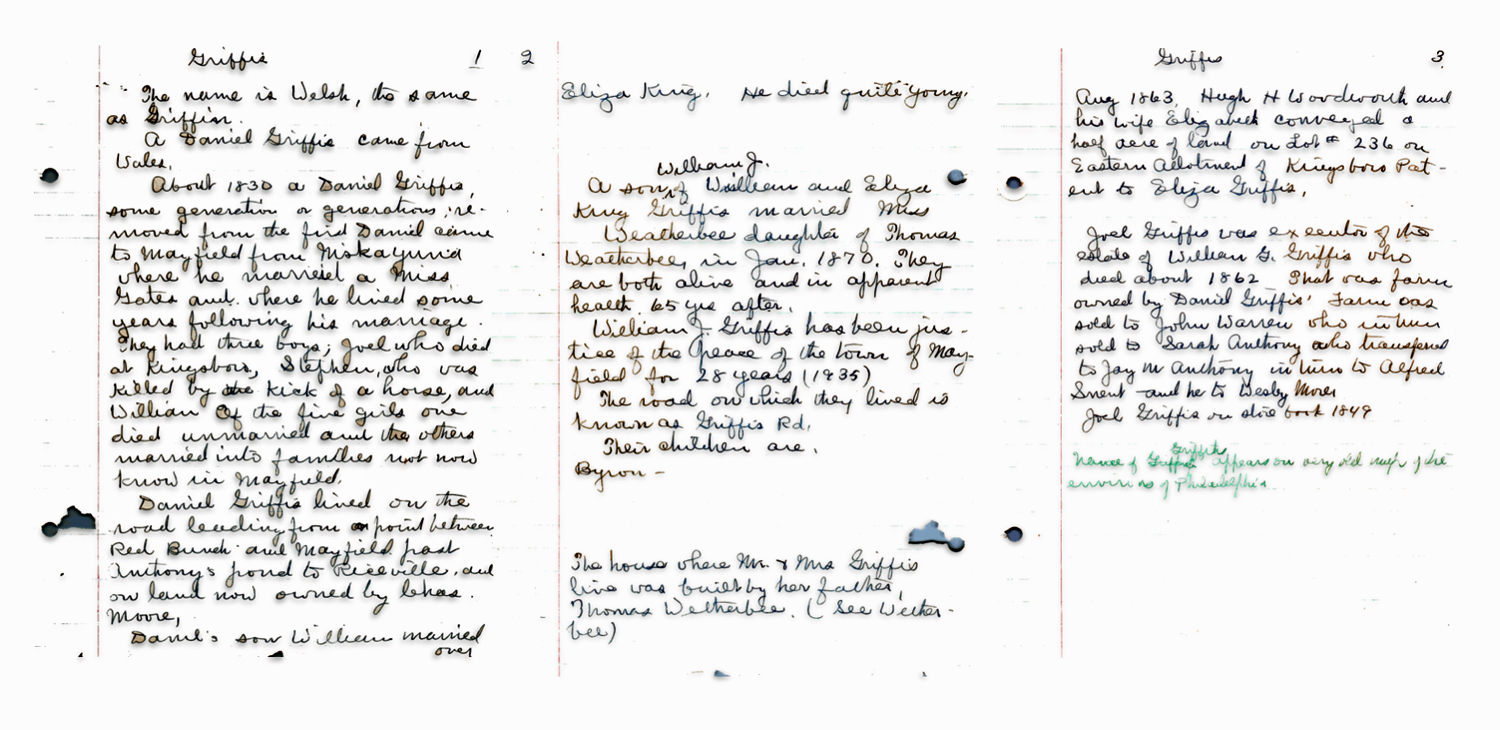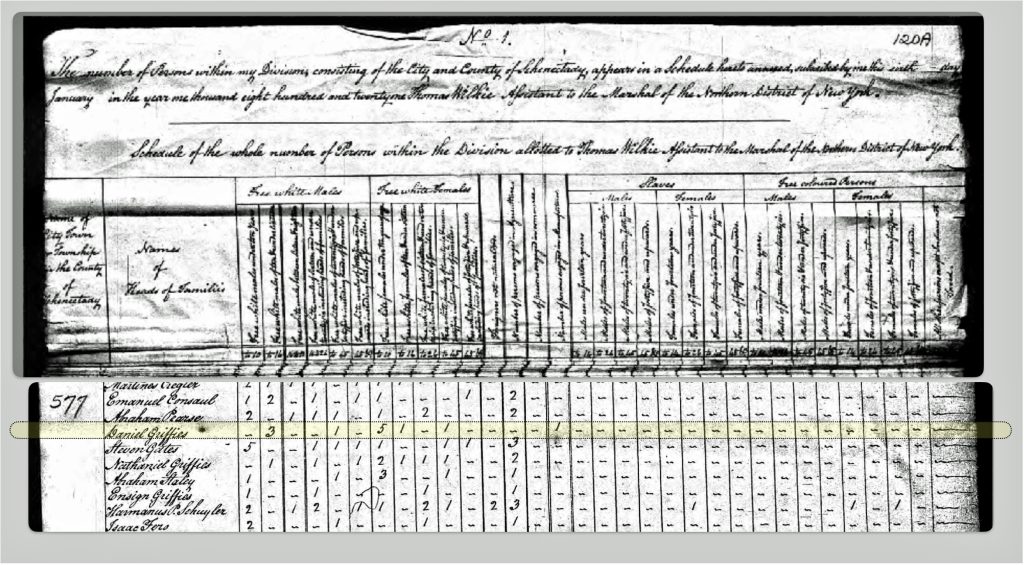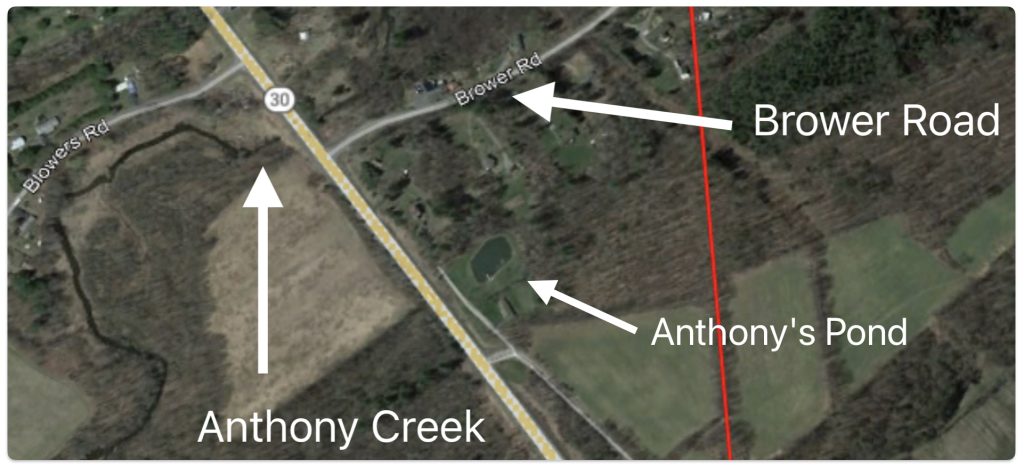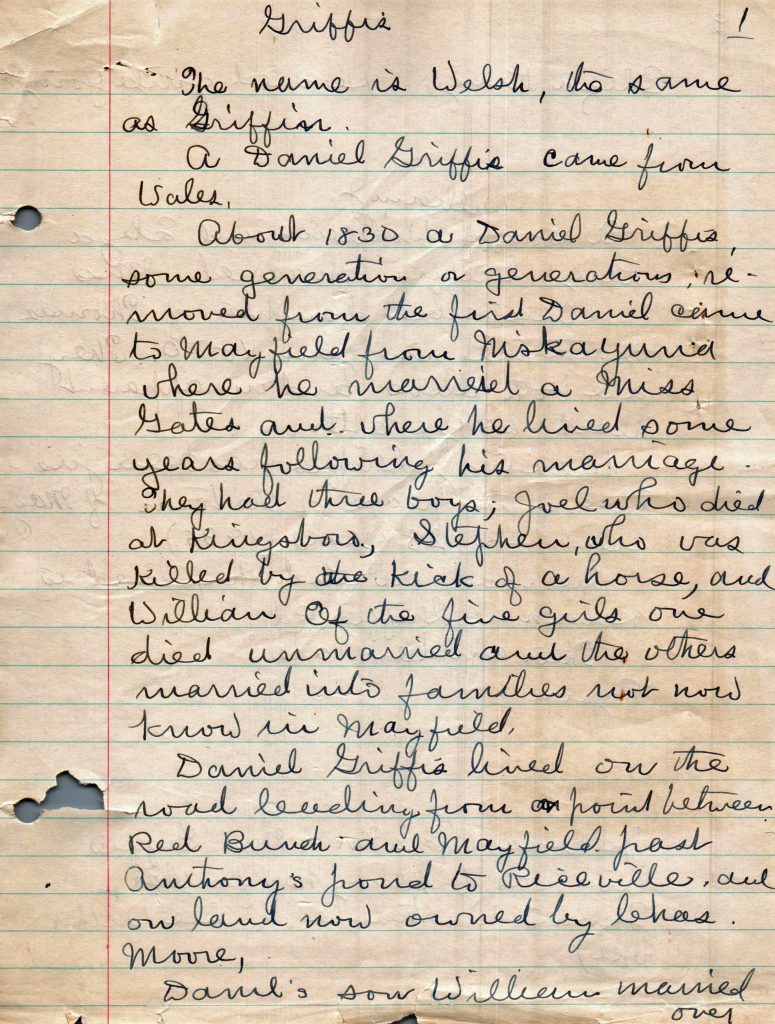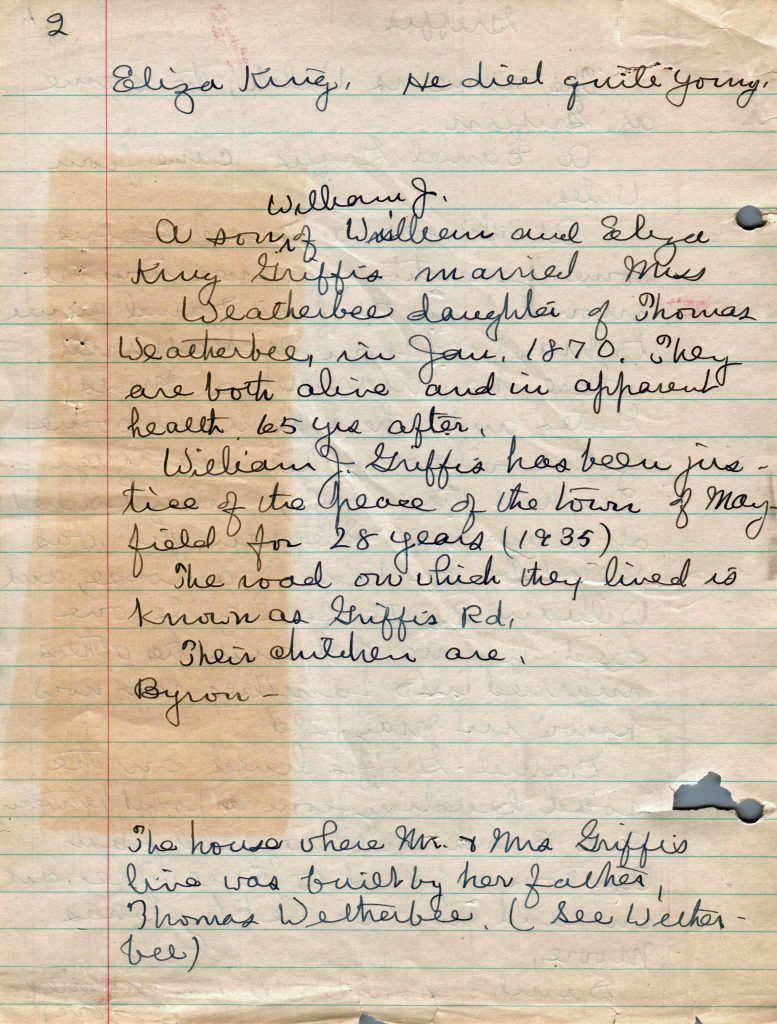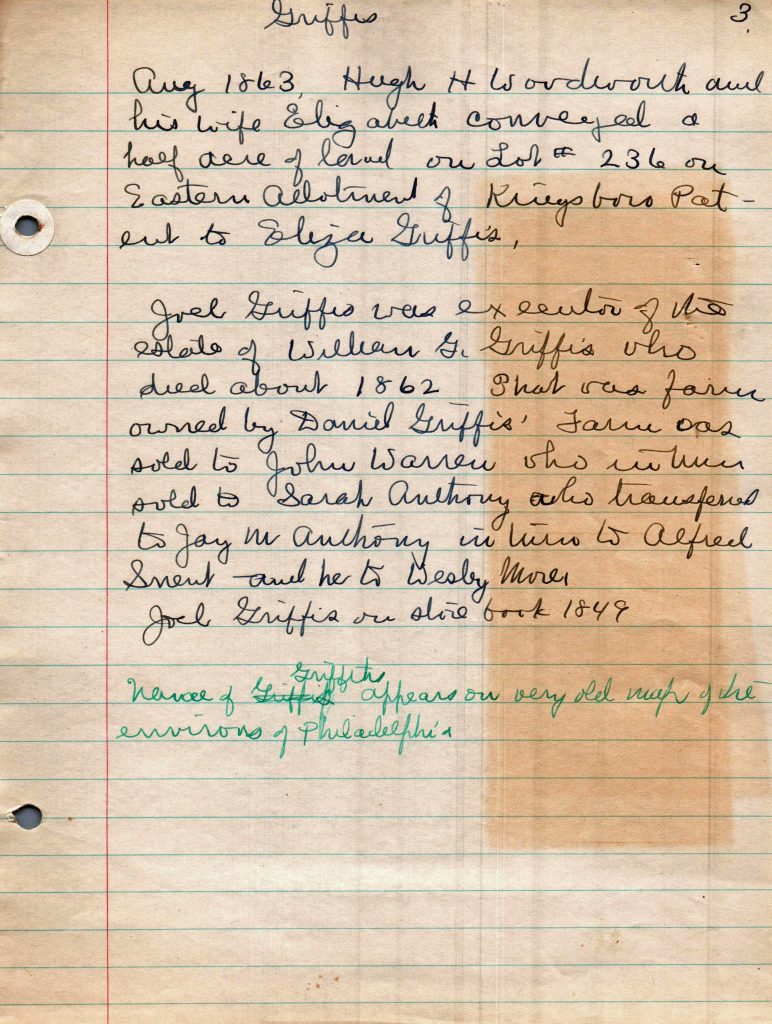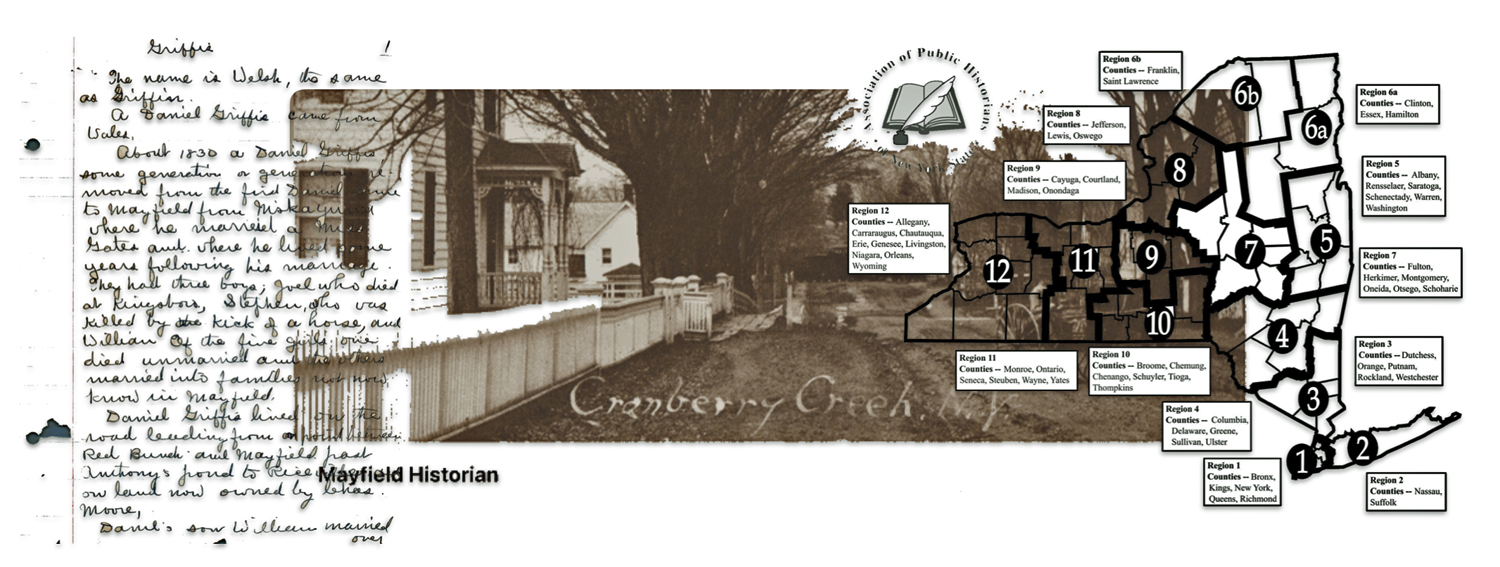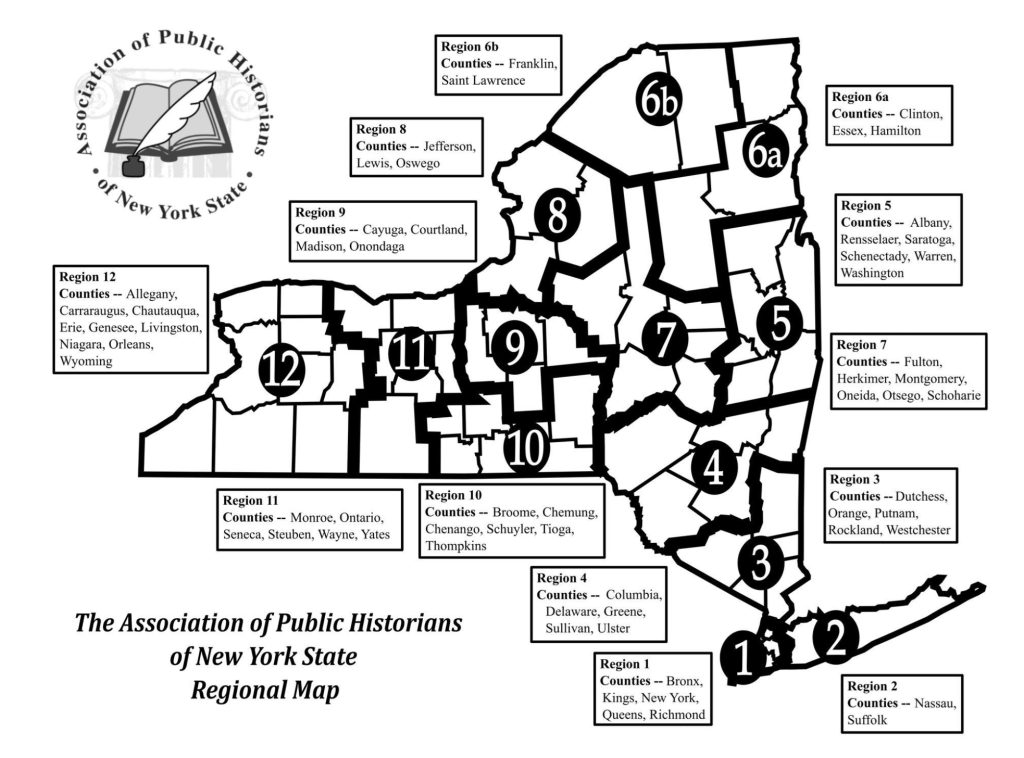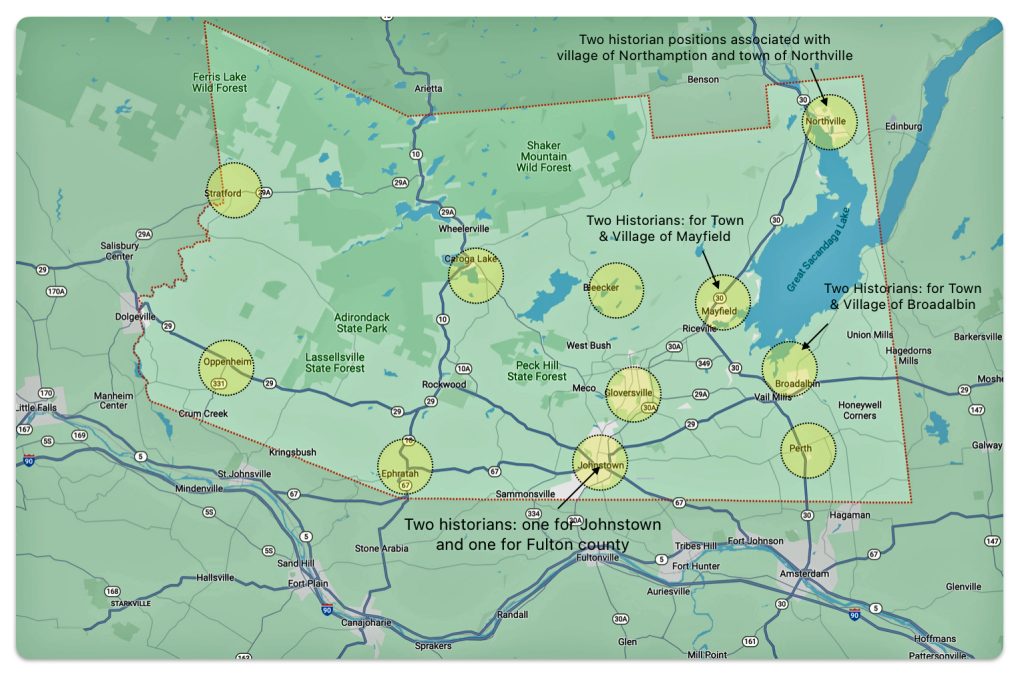As indicated in a prior story (see:The Virtues of Town Historians and Oral Histories, March 13, 2024), I obtained copies of handwritten notes on the Griffis family that lived in Mayfield, New York in the mid 1800s through the 1930s. [1] The three pages of handwritten notes were kept by a former Town of Mayfield, New York Historian, the Reverend Edward Ruliffson. Ruliffson’s notes were based on information he received in 1935. [2]
Based on the text of the notes, it appears Edward Ruliffson obtained a large portion of the information from William J. Griffis. Willam J. Griffis is my first cousin 4 times removed. [3] Our common family denominator is Daniel Griffis. Daniel is my great4 grandfather. Daniel is William J.’s grandfather. It is not known how much of the information contained in Ruliffson’s notes were the product of his personal research.
Oral History and Genealogy
Oral family history is a valuable tool for preserving personal narratives and connecting generations. However, it must be approached with an understanding of its limitations and with strategies to mitigate potential biases and inaccuracies.
Oral history can be a powerful tool for historical research, if it is combined with other sources and methods, and if it is understood as a form of evidence rather than an absolute truth. It can be used to complement and enrich other sources, such as documents or artifacts, by providing personal and contextual details. It can also challenge other sources by exposing gaps or contradictions, or by offering different interpretations or explanations. Additionally, oral history can create and contribute new sources by documenting and preserving the voices, stories, and experiences of people who may not be remembered otherwise.
There are also limitations that should be taken into consideration when evaluating the facts obtained through oral or written interviews:
- Memory and Recall Issues: Oral history relies on the memory of individuals, which can be influenced by time, age, trauma, bias, and other factors.
- Subjectivity: The formation is subjective and influenced by personal biases, which may lead to distortions or inaccuracies.
- Verification Challenges: There can be a lack of corroborating evidence, making it difficult to verify or cross-check information.
- Single Perspective: Oral histories often represent a single person’s viewpoint, which can lead to an incomplete or biased historical record.
- False Memories: Individuals may recall false memories, especially for events that occurred many years ago.
- Interview Dynamics: The relationship between the interviewer and interviewee can create dynamics that affect the narrative, the nature of questions asked and how answers are provided based on the context of the interview.
The notes on the Mayfield Griffis family are an invaluable resource for efforts at documenting certain facts about the Griffis family genealogy. They depict the information that Ruliffson may have obtained through discussions with William J. Griffis, other locals in the town and local documents. Information that he gleaned from William J. Griffis perhaps was based on what was passed down by his father and grandfather.
While his notes are not complete and raise many questions, they do contain interesting leads on ‘new’ facts for further research. The information contained in his notes also corroborate facts that I have been able to document from other sources. If the leads cannot be further traced to corroborating evidence, then we have additional tales that can be added to the family folklore.
The First Five Observations from Ruliffson’s Notes
The Rev. Ruliffson’s notes on the Griffis family in Mayfield, New York raise ten major points of interest or facts about members of the Griffis family. Part One of this story discusses the first five points in his notes. In the context of discussing his statements of facts, I have provided a comparative analysis of his statements of facts with the results of my genealogy research. The first five points in his notes deal with the origin of the Griffis family and the family of Daniel Griffis.


“The name is Welsh, the same as Griffin. A Daniel Griffis came from Wales.”
As reflected in a number of stories I have posted, the questions of (1) the ethnic origin of the surname and (2) who was the original descendant that immigrated to the American colonies have been perennial genealogical questions. Through Y-DNA testing and analysis, I am fairly certain that the Griffis(ith)(es) surname used by our descendants is associated with individuals that can be traced to modern day Wales. [4]
According to Ruliffson, the family surname was Welsh and a Daniel Griffis immigrated to the American colonies. I presume Ruliffson obtained this information from discussions with William J. Griffis. It was not known how many generations back this Daniel Griffis was situated in the family tree and when this Daniel came to the American Colonies.
Presently, based on other genealogical sources I have pushed our knowledge of the Griffis surname for our particular family back to a William Griffis(th) who was baptized on June 6, 1736 in Huntington, Suffolk County, New York. This conclusion is largely based on the following sources of information:
- documentation that the surname had changed among and between branches of the family in the 1700’s;
- records of the First Church in Huntington, Long Island which provided baptism and marriage records related to family members;
- information from three manuscripts on the Griffis(th) family of Huntington provided corroborating facts and additional information on various Griffis(th)(es) family branches;
- the discovery of family trees on the internet listing William Griffis(th) and his 12 children; and
- Federal and New York state census data
- newspaper articles in the 1800s; and
- land or deed records..
Ruliffson does not mention that the surname may have possibly changed from Griffith to Griffis, as Albert Buffet Griffith stated to his daughter-in-law Lillian Soper Griffith. Albert is a descendant of the second son of James Griffis. Except for one of his seven children, all of his descendants went by the surname of ‘Griffith’. [5]
Albert Buffet Griffith also told his daughter-in-law, Lillian that “his great, great grandfather’s name was Samuel”. [6]
If Albert Griffith’s recollections are true, then William’s father was perhaps Samuel Griffith. This does not refute Ruliffson’s statement that a Daniel Griffis came from Wales. Perhaps the father of Samuel, who purportedly was William’s father, was Daniel. This would imply that William Griffis(th)’s grandfather was the first generation to arrive in the colonies. However, we have no corroborating proof to substantiate whether a Daniel Griffis or Griffith came from Wales.
Another source that touches upon the subject of when and what descendant arrived to the colonies is the ‘Jones-Welch manuscript’. This unpublished manuscript provides a wealth of information, some of which is not substantiated with corroborating facts on the family tree. [7] The manuscript focuses on William’s fifth son, named William Griffith, who was born in 1763 and died in 1847. (There are a number of William and James’ in the family.) It also provides a brief discussion on William Griffith’s ancestors. William’s (born 1763) descendants are largely found in the Ontario, Canada area, Colorado, Illinois, Wisconsin and other areas of teh United States. He had a grandson, William Case Griffith (born 14 June 1825 in Chatham, Ontario, Canada and died July 27, 1902 in Beaver Dam, Wisconsin). The grandson wrote the following notes in his father’s journal after his father’s death. His father was Reverend William Griffis:
“My Great Grandfather, on my father’s side came from Wales and settled in Huntington, Long Island. They spelled the name Griffiths. My Grandfather, who died at my Father’s house could never give me any reason why he changed it to Griffis. He moved to Canada and settled at Adolphustown where my father was born, also three brothers of my father, Phillip, Stephen and Gilbert and one sister who married a Mr. Harris. My father’s mother, Content Harris, was born in England. I have my grandfather’s old pension certificate for the services in the Rev. War. He had to go to Albany for his pension.” [8]
Another manuscript that deals with the Griffith(s)(in) family of Huntington was written by Martha K Hall, Griffith Genealogy: Wales, Flushing, Huntington. It was an unpublished Manuscript written in 1929 and originally published 1937. [9] It has been reproduced for commercial access by a variety of publishers since the work is in the public domain. A PDF copy of the book can be found here. This brief manuscript was the foundation for another unpublished family manuscript: ‘The Peets – Welch manuscript’. [10]
Without any explanation or reason for introduction, Hall mentioned a Richard Griffen who emigrated from Wales and was one of the first settlers on Long Island. He lived in Flushing and had several children. Hall cites a source from the Abstracts of Wills and Deeds in New York that references 12 of Richard’s children, one of which is a Samuel Griffin. Hall infers a possible link with this Samuel Griffin with William Griffith wthout any corroborating evidence.
“The first Griffin record is that of William baptized in Huntington by Rev. Price June 6, 1736. It is possible he was the grandson of Samuel (Griffin).” [11]
We have a number of leads and suppositions from various sources about the ancestors of William Griffis(th) of Huntington, New York. All of these leads are based on oral history. However, we do not have corroborating evidence to confirm any of these sources and statements about a Daniel Griffis or a Samuel Griffis(in)(ith).


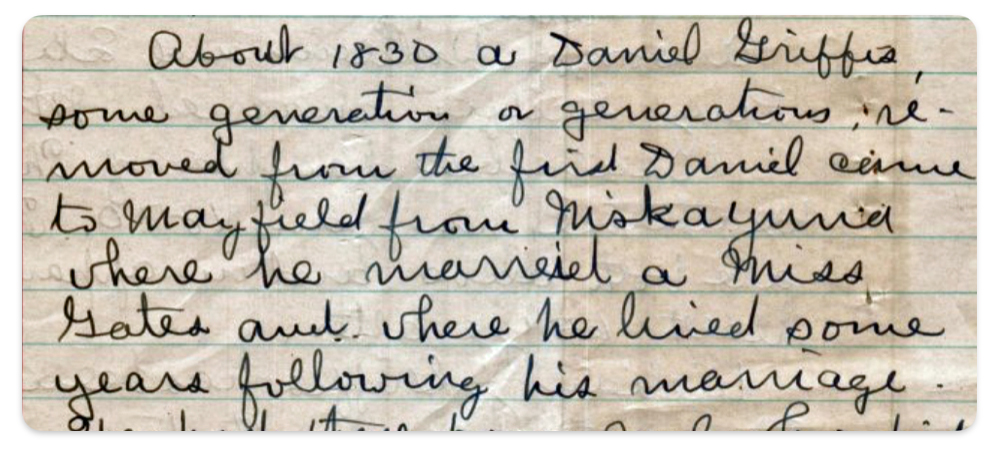
“About 1830 a Daniel Griffis, some generation or generations removed from the first Daniel came to Mayfield from Niskayuna where he married a Miss Gates and where he lived some years following his marriage.”
There are two observations in this statement: (1) Daniel moved from Niskayuna to Mayfield in the 1830s and (2) Daniel married a ‘Miss Gates’ possibly in Niskayuna, New York.
➊ Moving from Niskayuna to Mayfield
The observation about a Daniel Griffis living in Niskayuna in the 1830s before he came to Mayfield is corroborated by Federal and New York state census and Fulton county land assessment records. A land assessment record indicates Daniel Griffis acquired land from Alexander M. and Elizabeth A. McKinlay on June 1, 1837 in Fulton County, New York. [12] The land he acquired was in East Kingsboro, and consisted of two parcels in land patients 238 and 247. This confirms that Daniel relocated to Mayfield at least by 1837 and that Daniel owned land in Fulton in 1837. In 1841 Daniel transferred a parcel of land to his son William G. Griffis. [13]
Prior to 1837, we do not know the exact date that Daniel moved to the Mayfield area. Unfortunately, the 1835 New York census is not available to determine where Daniel lived. [14] We do know Daniel and his family resided in Niskayuna in 1830. [15] As reflected in table one, in 1830 Daniel was 53 years old. It appears that his wife is living with him and is between the ages of 50 – 59. In addition to Daniel and his wife, there is a young adult male in his 20’s and a young female between the ages of 5 and 9 living the household.
Table One: 1830 Household of Daniel Griffis in Watervliet, New York
| Sex | Census Age Group | Number in Household | Imputed Birth Date |
|---|---|---|---|
| Male | 20 -29 | 1 | 1801 – 1810 (a son ?) |
| Male | 50 – 99 | 1 | 1771 – 1780 (Daniel b. 1777) |
| Female | 5 – 9 | 1 | 1821 – 1825 (daughter?) |
| Female | 50 – 59 | 1 | 1781 – 1790 (wife) |
Based on a review of 1840 Federal census information, Daniel moved away from the Niskayuna, New York area and was living in Fulton County, New York. Daniel Griffis is found in the 1840 Federal Census in Mayfield, New York. As reflected in table two, his household had five individuals, all were reported as being employed in agriculture. The household had one male between the ages of 30-40 (presumably his son William Griffis), a male between the ages of 60-70 (presumably Daniel), two females between the ages of 20-30 (perhaps two daughters), and a female between the age of 50-60 (presumably Daniel’s wife). [16]
Table Two: 1840 Household of Daniel Griffis in Mayfield, New York
| Sex | Census Age Group | Number in Household | Imputed Birth Date |
|---|---|---|---|
| Male | 30 -39 | 1 | 1801 – 1810 (one of his sons William or Joel?) |
| Male | 60 – 69 | 1 | 1771 – 1780 (Daniel) |
| Female | 20 – 29 | 2 | 1811 – 1820 (daughters or one daughter and a daughter in law?) |
| Female | 50 – 59 | 1 | 1781 – 1790 (Daniel’s wife) |
The information in the 1855 New York state based census is noteworthy. The information contained in the 1855 New York census initially helped with my tracing the Griffis families back from Mayfield to the Schenectady, New York area in the early 1800’s. It was the first New York census to record the names of every individual in the household. It also asked about the relationship of each family member to the head of the household, something that was not asked in the Federal census until 1880. The 1855 New York state census also provides the length of time that people had lived in their respective towns or cities as well as their state or country of origin. This is particularly helpful for tracing the movements of ancestors. If born in New York State, the county of birth was noted, which is helpful for tracing migration within New York State. [17]
Image One: Daniel & William Griffis – 1855 New York Census – Mayfield
In the 1855 New York State census, reflected in image one above, the census enumerator documented that Daniel Griffis lived in Fulton country for 20 years and was born in Suffolk County around 1777. This implies that Daniel moved to Fulton county in 1835. It also indicates that William Griffis had lived in Fulton county for 20 years. Daniel also reported that he was a widower. [18]
➋ Daniel’s Wife – An Enigma
Until reading Ruliffson’s notes, Daniel’s wife has been an enigma. Ruliffson’s statement that Daniel “married a Miss Gates … where he lived (in Niskayuna) some years following his marriage” is a new lead. Ruliffson tersely states that Daniel married a member of the Gates family. Since Daniel’s mother, Abiah, was a member of the Gates family, this implies Daniel may have married a first or second cousin.
In absence of marriage documents or other documents such as baptismal, church or other corroborating forms of records, I am reliant upon census records, transcribed oral records, and family relationships found in family trees to verify marital relationships. Since Daniel and his wife lived roughly between the 1790’s and the mid 1800’s, most of the census Federal and New York state census have limited information.
It was not until 1855 for the New York state census and in 1880 for the Federal census that names of all household members were listed. Prior to this, only the name of the head of household was listed. Frequency distributions are used to depict the number and composition of the household based on sex and age. In absence of names for each family member, one must rely on inference as to who might be captured in each age category in a census enumeration.
Until the discovery of Ruliffson’s notes, I have not been able to find any clues as to who Daniel might have married. I also do not know when he or his wife died. A review of various Federal and New York state census enumerations for 1850, 1855, and 1860 imply that Daniel passed away between June 4th, 1855 and before the Federal census was taken in June 1860. Daniel is last reported in the New York State census of 1855 at the reported age of 79. His wife passed away before the enumeration of the 1850 federal census. [19]
As reflected in table three, the household of Daniel Griffis reflects the changing composition of a farm household. A typical farm household in the 1800s may include two to three generations of family members. It may change due to the economic demands of farm production and the ability of family members being able to work.
As family members get older, a younger generation of family members may move from one home or farm to another farm of a relative to assume different roles of managing the farm. As reflected in table three, I believe that this happened with the Daniel’s household in the Mayfield area. By 1850, I believe Daniel’s wife has passed away. He now has, I believe, his older sister Esther Griffis living with him. [20] In addition, his son William is essentially running the farm. Sally is possibly the youngest daughter of Daniel while Stephen is a grandson, a son of Joel Griffis. In 1855, Daniel is essentially living on William’s farm with William’s young wife Eliza and their two young children. As stated earlier, Daniel had transferred the deed of land to his son William in 1841.
Table Three: Household Composition of Daniel Griffis – 1850 Federal & 1855 New York State Census
| Name | Household Members in 1850 Census | Household Members in 1855 census |
|---|---|---|
| Age of Daniel Griffis | 73 | 79 |
| Wm Griffis | Not noted but in household | Not in household |
| Esther | 86 | Not in household |
| Sally | 24 | Not in Household |
| Stephen | 16 | Not in Household |
| Eliza | Not in Household | 26 |
| William J. | Not in Household | 3 |
| Jeremiah | 2 |
A review of the Federal Census for the years 1810 through 1840 indicate that the household composition for Daniel Griffis reflected one female that could have been his wife (see table four). Based on information in these census enumerations, Daniel’s wife was probably born between 1781 – 1790. [21]
Table Four: One Female Noted in Household of Daniel Griffis for Specific Age Category
| Census Year | Female Age Category | Number of Females |
|---|---|---|
| 1810 | 26-44 | 1 |
| 1820 | 26 – 44 | 1 |
| 1830 | 40 – 50 | 1 |
| 1840 | 50 – 60 | 1 |
The 1840 Federal census indicates that Daniel’s wife was living in Mayfield, New York. Daniel was 63 years old. A female is listed as being between the ages of 50-59 which conceivably would have been Daniel’s wife.
It is plausible that Daniel’s wife was a “Miss Gates”. As indicated in a prior story, there was a close connection between the Griffis(es) families and the Gates families. The pater familias of the Griffis family, William Griffis, married Abiah Gates on January 27, 1756 in Huntington, New York. Both families were deeply intertwined through the next 50 years.
The Griffis(es) and Gates families were related by marriage and were close socially and geographically. Parts of their respective families appeared to follow each other in various relocations from Huntington, Long Island to the Watervliet, New York and Niscayuna, New York area.
The Town of Niskayuna, New York was created on March 7, 1809 and separated from the town of Watervliet, with an initial population of 681. [22] Stephen Gates led the way to relocating to the Niskayuna area after the revolutionary war. [23]
Stephen Gates was the ‘pater families‘ of the Gates family in the Watervliet / Schenectady / Niscayuna area. He was an uncle to Daniel Griffis and Nathaniel Griffes. Uncle Stephen Gates, a revolutionary war veteran, is found living in this area in the Federal Census in 1790 through 1830. [24] He died in 1837 and was buried in Vale Cemetery. [25] Vale Cemetery is located in Schenectady, New York.
Stephen’s nephew, Nathan Griffes(is), also a revolutionary war veteran. [26] Nathan followed his uncle’s path and located in the Niskayuna area. By 1810 both the Gates and Griffis(es) families had established roots in Watervliet, Albany County. [27]
Past research has documented that two of Daniel’s sons were born prior to 1810. While it is not inconceivable that Daniel could have had a child prior to his marriage, it is assumed he married his wife prior to having children. If this is true, Daniel and his wife were married at least before the birth of their first son, William Gates Griffis. William was born in 1804 or 1805. [28]
The 1810 census indicates that the household of Daniel Griffis had three males and one female under the age of 10. Nothing is known of the female under 10 years of age. If she was a daughter, it is not known if she was older than William. If she was older, then Daniel and his wife could have been married earlier than 1804. [29]
The following page reflected in image two reveals the household composition of Daniel Griffis. Each column in the 1810 census represents the number of white males and white females respectively by age categories and then the last two columns reflect the number of total free persons and number of slaves. [30]
Image Two: U.S. Federal Census 1810 – Daniel Griffis [31]
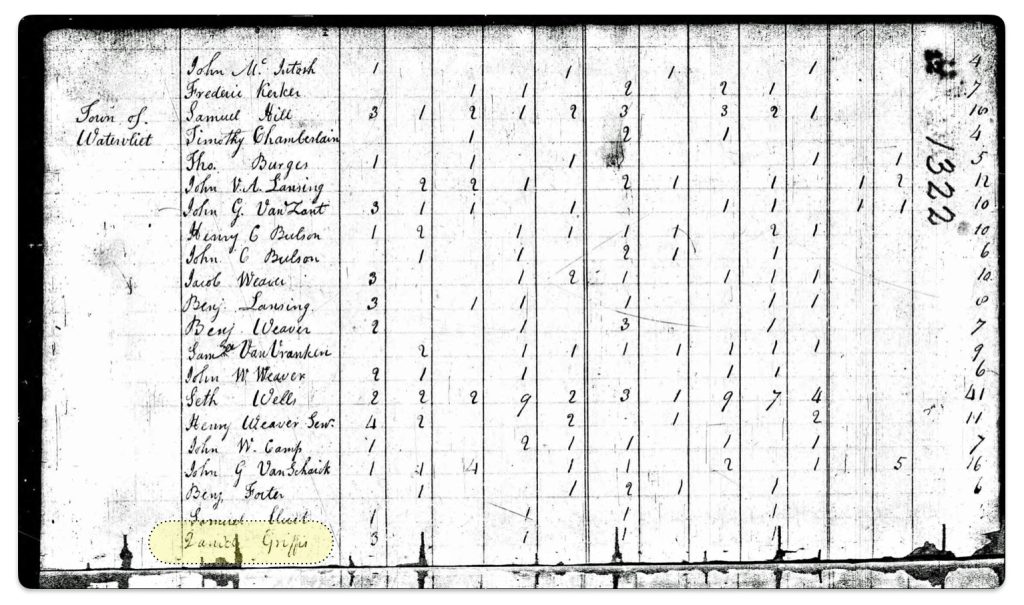
At the time of the 1810 census, Daniel would have been 33 years old, Daniel’s household reflects a young family. It was reported to have 3 males under the age of 10 (presumable three sons), one male between the age of 26 years and under 45 years (Daniel), one female under the age of 10 (a daughter) and one female between the age of 26 years and under 45 years (his wife).
As reflected in image three below, the 1820 Federal Census for Niskayuna, Schenectady County, lists three ‘Griffies’ families in close proximity based on the census taker’s enumeration path. It is assumed the census enumerator misspelled their names. However, one of Daniel’s older brothers, Nathaniel, spelled his name as ‘Griffes’. [32] In addition, between two of the ‘Griffies’ households, one headed by Daniel and another headed by Nathaniel, is a household headed by Steven Gates. There is also a household one house away from Nathaniel’s that is headed by an Ensign Griffies. Ensign is Nathaniel’s son who is just starting a new family with is wife and son, Samuel, age one.
It is noteworthy that there are only four pages of census for the town of Niskayuna. It was a relatively small town. There were 111 Niskayuna family households documented in the census on August 7, 1820. [33]
Image Three: 1820 U.S. Federal Census
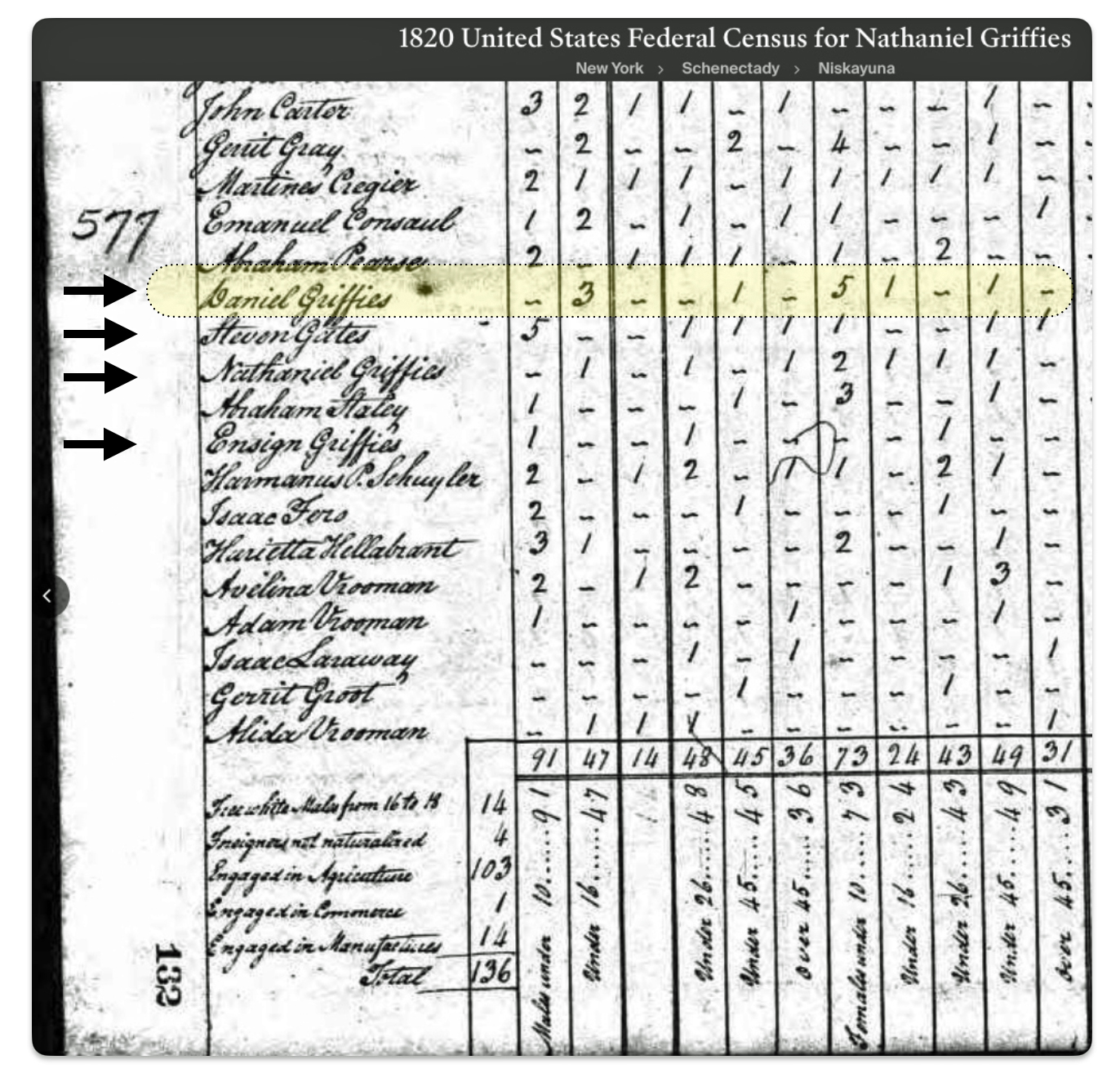
Page number 577 from the 1820 United States census (above) provides a graphic portrayal of close physical ties that existed between the Gates and Griffes(is) families. The connection between the families was not only physical in terms of living close to each other. Their ties were also based on mutual trust and affection between family members. This is reflected in the naming of children and legal representation. For example, Nathaniel Griffes was about midway in age between Stephen Gates and his sons, Stephen Gates Jr. and Daniel W. Gates. Stephen Gates named a son Nathaniel Griffis Gates. Nathaniel Griffes named Daniel W. Gates as one of his executors of his will. [34]
Image Four: Gates Family Generations in Context with Age of Daniel Griffis
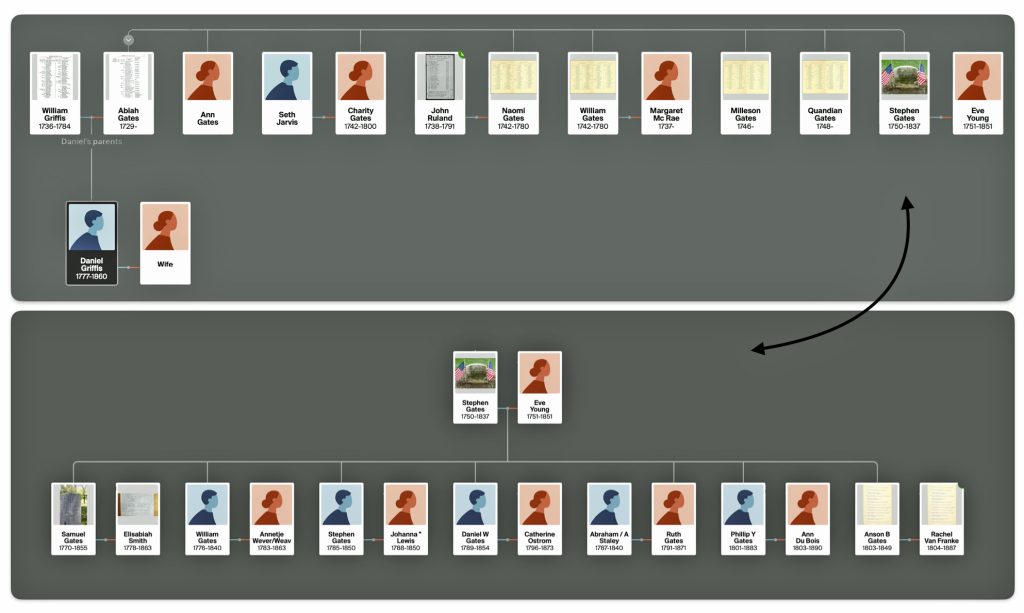
Hence, given the close ties between the Gates and Griffis(es) families, it is conceivable, possibly true, that Daniel married a “Miss Gates”. However, after a review of the Gates family kinship tree (see image four), I cannot find a possible ‘Miss Gates candidate’ in the Gates’ extended family that could have been Daniel’s wife. All of the Gates females were married. Some of the branches of the Gates extended family resided in Connecticut. Maybe he married a distant cousin. To the extent possible, I did not find any ‘available Miss Gates’ across the Long Island Sound. Daniel and his wife probably married shortly after the turn of the century in the early 1800s. This is all we presently know.


“They had three boys, Joel who died at Kingsboro, Stephen, who was killed by the kick of a horse, and William. Of the five girls one died unmarried and the others married into families not now known in Mayfield.”
Similar to information Daniel’s wife, my past research regarding the composition of Daniel’s family has left me with a picture that is not entirely in focus. I have been able to trace Daniel Griffis and parts of his family from 1810 through the mid 1850s. I knew he had more than two sons (probably three) and more than one daughter.
I have been able to trace descendants of two of his sons William Gates Griffis and Joel Griffis. Joel Griffis is my great3 grandfather. William Gates Griffis is the grandfather of William J. Griffis mentioned in Ruliffson’s notes. There is little or no Information on the remaining children. I have not been able to document a complete, consistent structure of Daniel’s family through time.

Ruliffson’s notes on the composition of Daniel’s family contain interesting leads on ‘new’ facts for further research. His notes also corroborate informed hunches I have about facts of Daniel’s family that I have been able to document from other sources.
Ruliffson indicates that Daniel had three sons and five daughters. He identifies Joel, Stephen and William as his sons. Unfortunately, none of the five daughters are identified by name. He indicates that one daughter did not marry and the remaining four married and lived outside of Mayfield. All of these ‘kernels of possible facts’ concerning Daniel’s children provide future leads for research and corroboration on a number of hunches I have had regarding his children.
As indicated earlier in this story, Daniel’s family existed at a time when it is difficult to document the specific composition of household family members based on the census taking practices in the Federal and New York state census. The family composition of Daniel’s family can only be inferred by analyzing the age distributions of males and females in the household over time. One can gain some specificity of who people are in a given age distribution by comparing available information found in possible marriage documents, church records, newspaper announcements, or death certificates of family members.
As reflected in image two above, Daniel had three sons and one daughter under the age of 10 in 1810. The 1820 Federal census (image five) perhaps provides the best year or snapshot of the composition of Daniel’s family. This is a period in time when most of his children are in their early or mid teenaged years and still living a home.
In 1820 Daniel was 43 years old. There are three boys between the ages of 10 and 14 and five females under the age of 10 and an additional female between the age of 10 and 14 in his household. Ten years later, the household composition of Daniel Griffis only contains a male in his 20s and a female between 5 and 9 and presumably his wife who was between the ages of 20 and 49.
If the census enumerator correctly tallied the individuals in Daniel’s household in 1820, Daniel had nine children.
Image Five: Household Composition 1820 – Daniel Griffis
My prior research suggested that Daniel Griffis had a third son, in addition to William Gates Griffis and Joel Griffis. I did not have corroborating proof of the third son but I had indirect evidence from the various Federal census preceding 1840. I had found the death of a Stephen Griffis from Schenectady in a data collection of Newspaper Extractions from the Northeast, 1704-1930 [35]. It states: “At Schenectady, on Tuesday (May 13, 1834) of last week Mr. Stephen Griffis (died), aged about 25 years.” Based on an interpolation of facts based on census age distribution tabulations for the household of Daniel Griffis over time, I assumed Daniel had a son that was possibly born around 1809. If this was the case, I assumed the Stephen Griffis mentioned in the newspaper extract could very well have been Daniel’s son.
Ruliffson indicates that Stephen was “killed by the kick of a horse”. If this is our Stephen, then how Stephen passed away is certainly ‘news’. It is not known if Stephen lived with his father at the time of his death.
In my prior research, a review of newspaper announcements in the Watervliet area revealed the marriage of a Ruth Griffis on the 20th of March, 1830. When I discovered this newspaper announcement, it was the first occurrence of Ruth Griffis in my research. A review of the names of daughters of Nathan Griffes and did not reveal a Ruth.
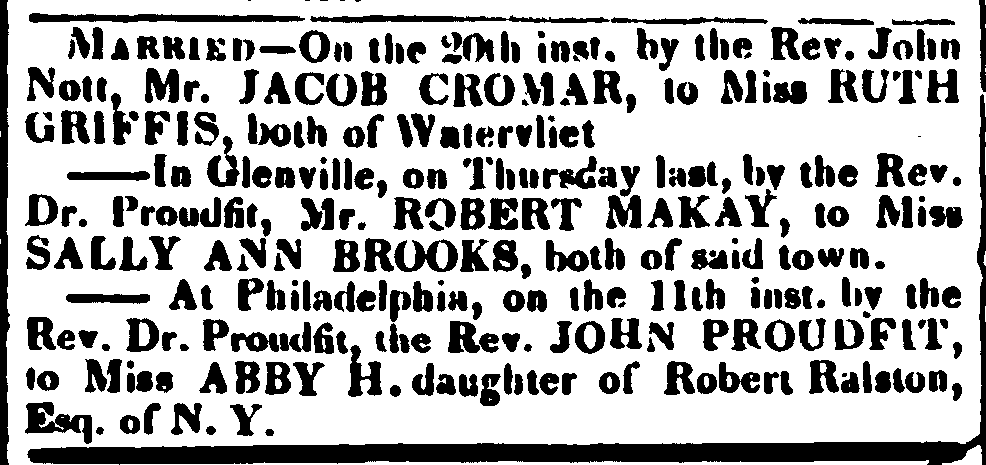
With nothing else to corroborate her relationship with the Griffis family, I researched the past of her husband, Jacob Cromar (Cromer). I went back to the 1850 census which listed individual names and was able to work backward, documenting the family of Ruth Griffis. In 1850, Ruth and her family lived in Charlton, New York. [36] A town that Ensign Griffis lived prior to his moving to Mayfield / Broadalbin. While I do not have absolute proof, the structure of the respective family households of Ensign Griffis and Daniel Griffis over time suggested that Ruth was Daniel’s daughter. I am assuming Ruth is the female in the 1820 census that was in the 10- 15 age group.
Table Five: Inferred Family Composition of Daniel’s Family
| Name | Relation | Birth Date |
|---|---|---|
| Daniel Griffis | Father | 1777 |
| Wife | Mother | 1781 – 1790 |
| William Gates Griffis | Son | 1804 – 1805 |
| Joel Griffis | Son | 1807 |
| Stephen Griffis | Son | 1809 |
| Ruth Griffis (Cromer) | Daughter | 1811 – 1812 |
| This might be Ruth | Daughter | 1811 – 1819 |
| – – – | Daughter | 1811 – 1819 |
| – – – | Daughter | 1811 – 1819 |
| – – – | Daughter | 1811 – 1819 |
| – – – | Daughter | 1811 – 1819 |
The 1820 census suggests that Daniel Griffis had nine children. Ruliffson’s oral history notes that Daniel had eight children. Based on my current research and information in this story, table five depicts a tentative ‘snapshot’ of Daniel’s family. It is possible that Ruth Griffis is one of the unidentified five daughters.


“Daniel Griffis lived on the road leading from (a) point between Red Brunch and Mayfield past Anthony’s pond to Riceville, and on land now owned by Lekas (sp?) Moore.”
As indicated in my discussion of Daniel Griffis moving from the Niskayuna area to the Mayfield area, of New York state, Daniel Griffis purchased land in Mayfield in June, 1837. A review of the June 1, 1837 land deed indicates that Daniel paid $619.00 dollars for 110 acres “more or less excepting therefrom and hereby always reserving the mile lot thereon containing one acres or less, with the saw mill on the Creek aforesaid with privileges and appearances thereunto belonging and the privilege of a lane from the highway to said saw mill and mill lot the whole.” [37]
The deed also indicates that the 110 acres are located in sections 238 and 247 of the East Kingsborough patent. Daniel purchased the two parcels from Alexander and Elizabeth McKinlay on January 1, 1837. The portion of a 1828 Map of Fulton county (below) indicates the location of sections 238 and 247 of the Kingsborough Patent.
Map One: County of Montgomery 1828 [38]
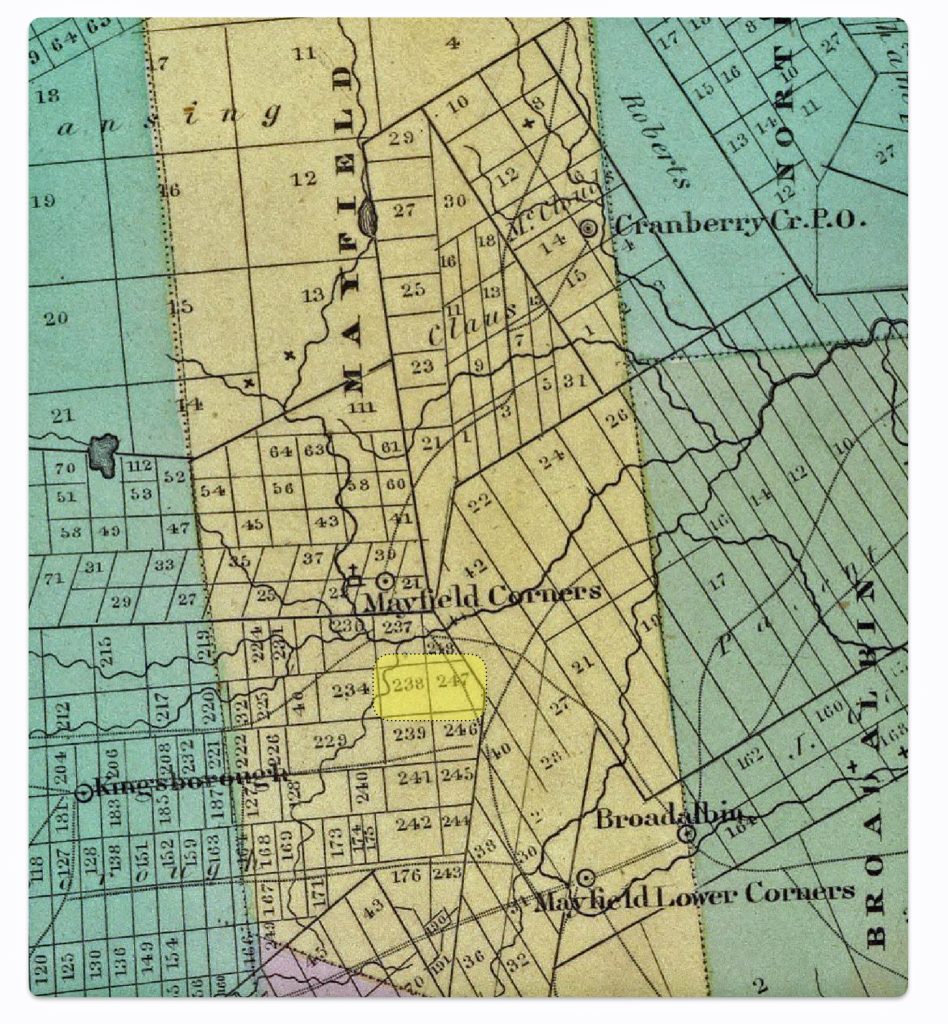
The Kingsborough Patent [39] contained parts of the current Towns of Johnstown, Mayfield, and Ephratah, including the present-day cities of Johnstown and Gloversville.
Ruliffson provided a descriptive account of a road on which Daniel Griffis lived in the lte 1830s based on landmarks and roads that existed in the 1930s. The track of land or the current farm in the mid 1930s was located on a road in between Red Bunch and Mayfield, “past Anthony’s Pond”.
If you are not familiar with the local area of Mayfield, a former Mayfield Historian indicated that:
“Red Bunch, East of Mayfield village supposedly was named after many of the business places and houses which were painted red. This area was also known as Mayfield Corners in later years… “ [40]
Red Bunch or what is now called “Red Bunch Corners” is currently a hamlet in the southern part of the town on route NY-30. It is situated nearby to the hamlets Munsonville and Riceville. [41]
Anthony’s pond does not appear on any historic or contemporary maps that I have been able to review. However, there is an Anthony’s creek that runs southwest-ward from what is now the Great Sacandaga Lake and crosses the contemporary state route 30.
History of the Kingsborough Patent
The Kingsborough and Mayfield patents refer to distinct historical land grants in New York, each with its own background and historical significance.
Map Two: 1774 Map of the Mayfield and Kingsborough Patents [42]
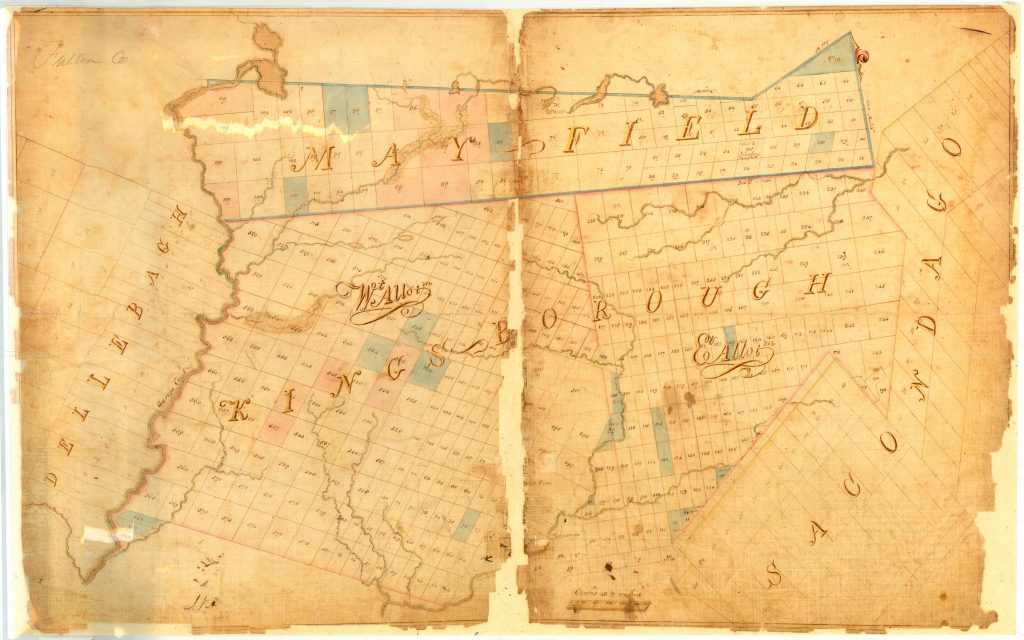
The Kingsborough Patent, granted on June 23, 1753, to Arent Stevens and others, encompasses a significant portion of land, specifically twenty thousand acres, within what is now Fulton County, New York. [43] This land grant process is a notable part of the region’s colonial history, reflecting the broader patterns of land distribution and settlement in the American colonies during the 18th century.
The Kingsborough Patent, along with other land grants like the Mayfield and Sacandaga Patents, reflect the methods used during the colonial period to encourage settlement and development of the New York colony. Large tracts of land were often obtained by single individuals or small companies through the formation of companies that included the purchaser(s) and as many “dummies” or paper men as there were thousands of acres in the desired tract of land. This practice, although somewhat circumventing laws intended to limit the size of individual land grants, facilitated the acquisition of substantial areas for development and settlement
Based on the work of the Mayfield Historian Eric Close, the contemporary location of sections 238 and 247 of the Kingsborough Patent are depicted in map four below. The red boundary depicts the two sections of the east Kingsborough patent. [44]
Map Three: Contemporary Location of Sections 238 and 247 of the East Kingsborough Patent
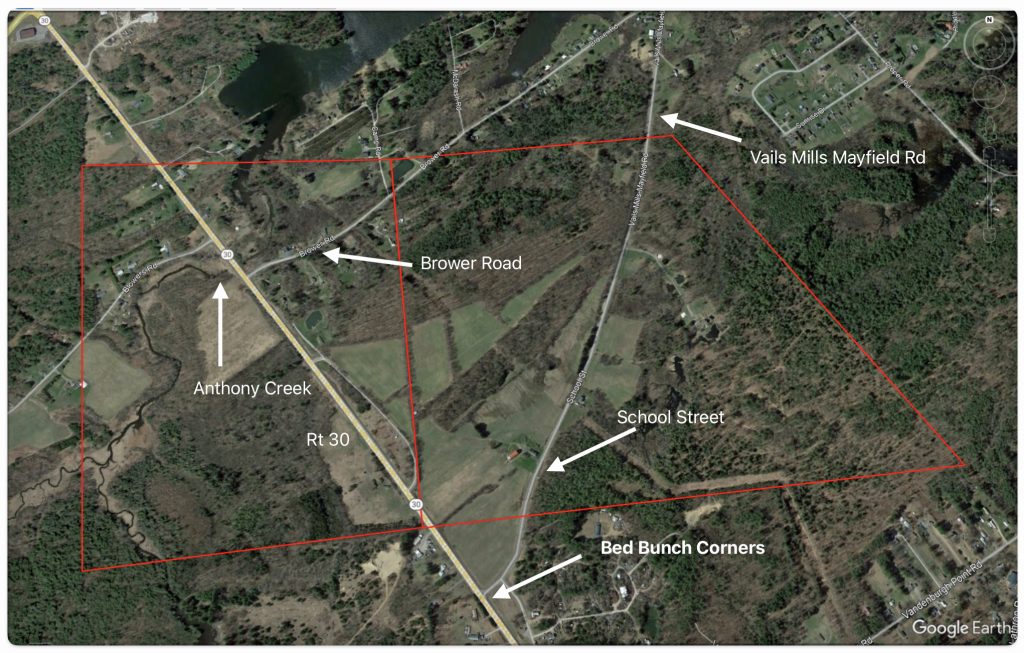
The map developed by Eric Close provides an excellent depiction of the two patent sections in contemporary time and gives an idea of the approximate location of where Daniel’s property was located. One must consider the changes of major roads (between the 1830s to the 1830’s, when Ruliffson made his notes, and the present day) when attempting to determine the approximate location of Daniel’s property. In map three above, Route 30 diagonally bisects land patent section 238 from the northwest to southeast. Route 30 did not exist during Daniel’s lifetime.

Several roads were replaced by or eventually became part of New York State Route 30 over time. In January 1930, the U.S. state of New York implemented a major renumbering of its state highways. Many previously existing numbered routes were renumbered or realigned. At the same time, many state highways that were previously unnumbered received designations. [45] In Fulton County, New York 30 crosses New York (NY) 29 near Broadalbin, then curves slightly to the east after an intersection with County Route 155 (County Road 155), a historical routing of NY 29. 0.25 miles (0.40 km), NY 30 turns left toward Mayfield; CR 155 continues eastward. The concurrency between the two routes is unsigned.
New York Route 30 historically followed School Street through the village of Mayfield. The new routing had it heading toward Riceville, where NY 30A rejoins NY 30. Here, the Adirondack Trail begins as NY 30 turns right, following the right-of-way of NY 30A into Adirondack Park shortly before entering Mayfield. [46]
Ruliffson indicated that Daniel’s property was on a road between Red Brunch and past Anthony”s Pond to Riceville. Riceville is to the north of patent section 238. The existence and location of Anthony’s pond in the 1800’s and early 1900s is not known. A review of available maps generated in the 1800s and contemporary maps do not indicate the presence of a pond. There is, however, an Anthony Stream that runs from the north east to the south west in section 238 and crosses Route 30, as reflected in map four below. Just south of the stream one can see a small unidentified pond on the east side of Route 30. It is presumed that the pond may have been close to Anthony stream. This might be Anthony’s Pond. A road that leads from a point in between these geographical markers mentioned by Ruliffson is Brower Road.
Map Four: Anthony’s Pond
If one looks at a blown up portion of Map One below (Map Five) , it is evident that the county roads did not conform to the road pattern of Route 30 reflected in maps three and four. The dotted lines in map five represent county roads at the time of 1828. I believe the dotted lines are incomplete in sections 248 and 230 due to the design of the map (the spelling of Mayfield Corners on the map obscures the county road routes). The county roads shown in section 230 and 248 probably connected in section 237 and went up to Mayfield Corners.
Map Five: Blown Up Section of County of Montgomery 1828
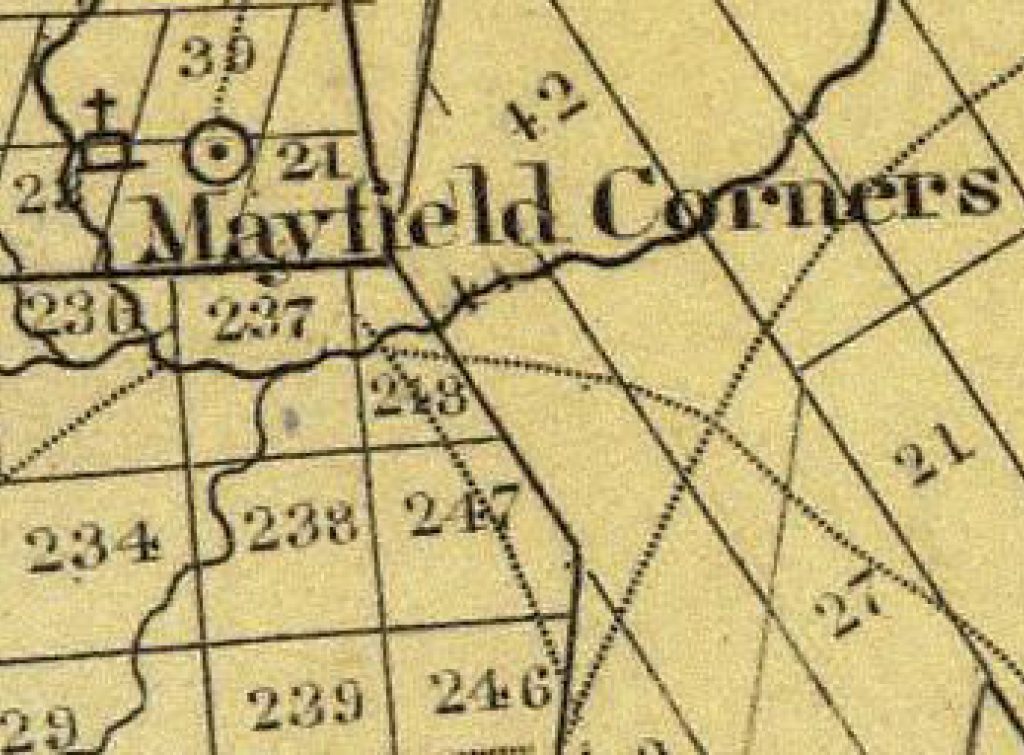
It would appear that Daniel’s land would have been west of the county road that runs south west through section 247 to the middle of the southern boundary of section 247. In addition, Daniel’s land possibly bordered Anthony stream and could be accessed on Brower road.
The deed to Daniel’s property provides a clue as to where it is situated. However, my knowledge of surveying terms and comprehending sentences that turn into paragraphs make me a bit disoriented when attempting to precisely map out the boundaries of his deeded farmland. [47]
The deed indicated that the property line went along the bank of a creek near property owned by the Chases and the Anthony’s. It also indicated that the property line goes along a highway to the north line of section 247.
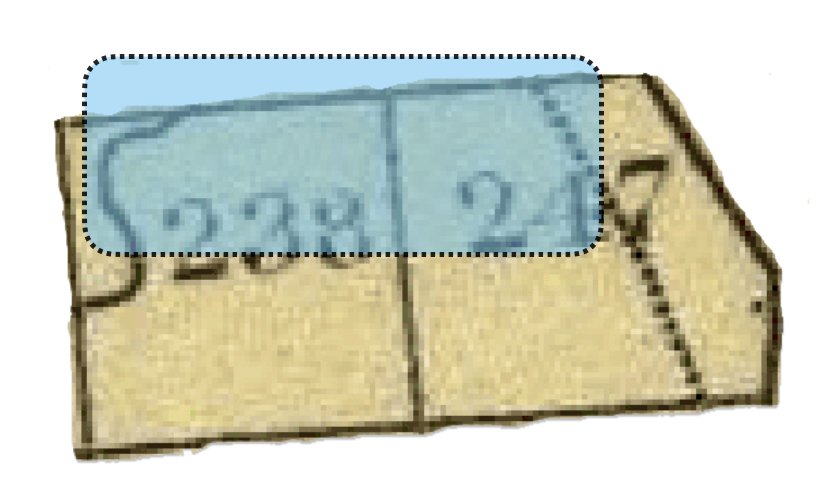
The information contained in the land deed along with information in the 1828 map of the Kingsborough patent suggests Daniel’s farm spanned both sections of patents 238 and 247. Its west boundary included the creek. The eastern boundary was next to the county road and followed the higway up to the northern line of the section.
The land deed points out an interesting point regarding the ownership and access to a saw mill and mill lot located on the creek. The deed indicates ownership to 110 acres “more or less”, reserving the mile lot that contains the saw mill and “the privilege of a lane from the highway to said saw mill and mill lot”.
Survey Description of Daniel’s Land
“Beginning at the South East corner of lot number 238 running on the South line of lot South 88 degrees and 30 minutes west to the East bank and 30 west to the East bank of the Creek, at high water mark, down the East bank of the creek at the highwater mark as it winds and turns to a line drawn parallel with the south line of the lot through the middle of lot; on the said line North 88 degrees & 30 minutes East to the East line of said lot; thence along the same being the west bounds of said lot number 247 North one degree and 30 minutes west to the highway leading from Anthony to Chases; thence North Easterly along said highway to the north line of said lot number 247 thence, along said north line, north 88 degrees and 30 minutes east to a Stake and Stones 11 chains and 50 links from the North west corner of said lot last mentioned; thence South one degree and thirty minutes twenty four chains and fifty links; thence North Sixty degrees East seventy one links; thence South forty one degree & thirty minutes East four chains & thirty five links; thence South fifty three degrees and twenty minutes west seventeen chains and Eighty Seven links to the west line of said lot last mentioned; thence along the same south one degree and thirty minutes East to the place of Beginning supposed to contain one hundred and ten Acres more or less excepting therefrom and hereby always reserving the mile lot thereon containing one acres or less, with the saw mill on the Creek aforesaid with privileges and appearances thereunto belonging and the privilege of a lane from the highway to said saw mill and mill lot. “
There is an 1856 map of Fulton county from actual surveys that show property owners. However, based on a review of landowners in the map, a Griffis family farm was not found. [48]
Information on Daniel’s farm was captured in the 1850 Agricultural Non-Population census for the Broadalbin and Mayfield, New York areas. Daniel had a sizable farm. The Federal agricultural census indicated that Daniel had eighty of the 110 acres improved for farming. He had two horses, one milk cow and other cattle. Daniel also had seven pigs. He mostly grew corn and had oats as a secondary crop and to a lessor extent barley, buck wheat and hay. [49]
U.S. Selected Statistics Federal Census Non-Population Schedules, 1850, New York Agriculture, Fulton County, Mayfield
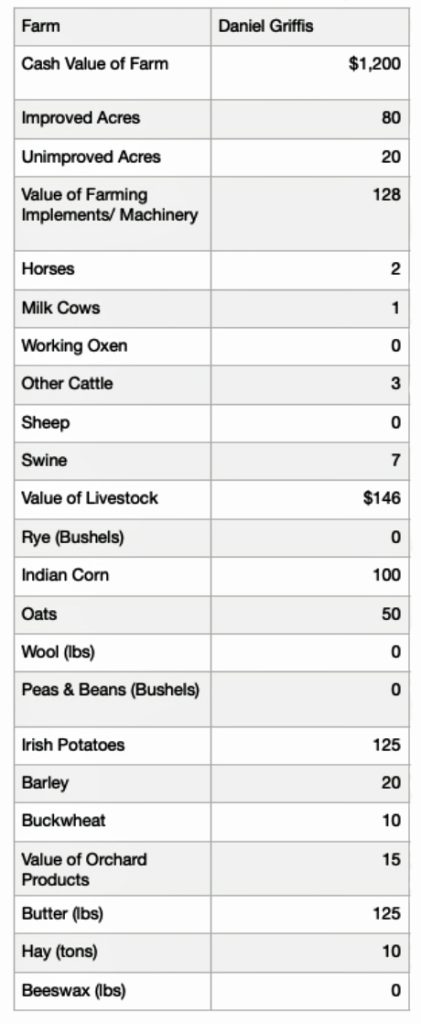
Hence, while we know Daniel had 110 acres that spanned part of two patent sections just south of the town of Mayfield, it is not certain as to the specific boundaries of the farm. It is believed access to his farm was on Brower Road.
Part two of this story discusses the remaining five obsverations of Mayfield historian Ruliffson on hte Griffis family..
Sources
Feature photograph: An amalgam of the three pages of notes taken by Mayfield Historian Edward Ruliffson in 1935 on the Griffis Family in Mayfield, New York
[1] March 7, 2024 e-mail from Eric Close, Mayfield Town Historian.
[2] The following are copies of the original three pages:
[3] A first cousin four times removed is a relative who is four generations above (or below) you in your family tree. This means that the common ancestor you share with this cousin is either your great-great-great-grandparent or the great-great-great-grandchild of your great-great-great-grandparent. The term “removed” indicates the number of generations between you and the cousin in question. In this case, “four times removed” means there is a four-generation difference between you and your cousin
Jessica Grimaud, Cousin Chart—How to Calculate Family Relationships, July 23, 2019, FamilySearch Blog, FamilySearch, https://www.familysearch.org/en/blog/cousin-chart
Daniella Levy, How Many Times Removed? Untangling Distant Family Relationships, MyHeritage Knowledge Base, https://education.myheritage.com/article/how-many-times-removed-untangling-distant-family-relationships/
[4] See the following stories:
- Y-DNA & the Griffis Paternal Line Part Five: Using Y-DNA & Locating a Griff(is)(es)(ith) Relative and Other Leads March 3, 2023
- Y-DNA and the Griffis Paternal Line Part Four: Teasing Out Genetic Distance & Possible Genetic Matches from STR Tests February 24, 2023
- Y-DNA and the Griffis Paternal Line Part Three: The One-Two Punch of Using SNPs and STRs February 23, 2023
- Y-DNA and the Griffis Paternal Line Part Two: Snips and Strings and Other Interesting Things February 6, 2023
- Y-DNA and the Griffis Paternal Line – Part One September 26, 2022
[5] Albert Buffet Griffith is my second cousin four times removed.
The story is attributed to Albert Buffet Griffith (18 Sep 1826 Huntington NY – 24 Mar 1901 Huntington NY). His lineage in the Griffis(th) family reflects the changes in the spelling of the surname. His father was Peter Griffith (1792 Huntington NY – 1864 Huntington NY), his grandfather was James William Griffis (04 Jun 1758 Suffolk Co – 21 Nov 1838 Suffolk Co) and his great grandfather was William Griffis.
See: Mildred Griffith Peets, Griffith Family History in Wales 1485–1635 in America from 1635 Giving Descendants of James Griffis (Griffith) b. 1758 in Huntington, Long Island, New York, compiled by Capitola Griffis Welch, 1972 , page 9. PDF copy of the manuscript can be found here.
[6] Ibid, Page 8.
[7] The ‘Jones-Welch manuscript’:
Mary Martha Ryan Jones and Capitola Griffis Welch, compiled by, Griffis Sr of Huntington Long Island and Fredericksburg, Canada 1763-1847 and William Griffis Jr, (Reverend William Griffis) 1797-1878 and his descendants. A self published genealogical manuscript, 1969.
[8] Mary Martha Ryan Jones and Capitola Griffis Welch, compiled by, Griffis Sr of Huntington Long Island and Fredericksburg, Canada 1763-1847 and William Griffis Jr, (Reverend William Griffis) 1797-1878 and his descendants. A self published genealogical manuscript, 1969. Page 103.
[9] M.K. Hall, Griffith Genealogy: Wales, Flushing, Huntington, Unpublished Manuscript 1929, originally published 1937, Gardena, Calif.: RAM Publishers, 1965.
[10] Mildred Griffith Peets, Griffith Family History in Wales 1485–1635 in America from 1635 Giving Descendants of James Griffis (Griffith) b. 1758 in Huntington, Long Island, New York, compiled by Capitola Griffis Welch, 1972 , Page 8.
[11] M.K. Hall, Griffith Genealogy: Wales, Flushing, Huntington, Unpublished Manuscript 1929, originally published 1937, Page 5. Hall references: Meyers, Carol M. Early New York State Census Records, 1663-1772. Gardena, Calif.: RAM Publishers, 1965.
[12] Daniel Griffis, Grantee of Property United States, New York Land Records, 1630-1975.”Database with images. FamilySearch. https://FamilySearch.org : 17 February 2023. Multiple county courthouses, New York. Date : 1 Jan 1837, https://www.familysearch.org/ark:/61903/1:1:H59Y-MJ3Z
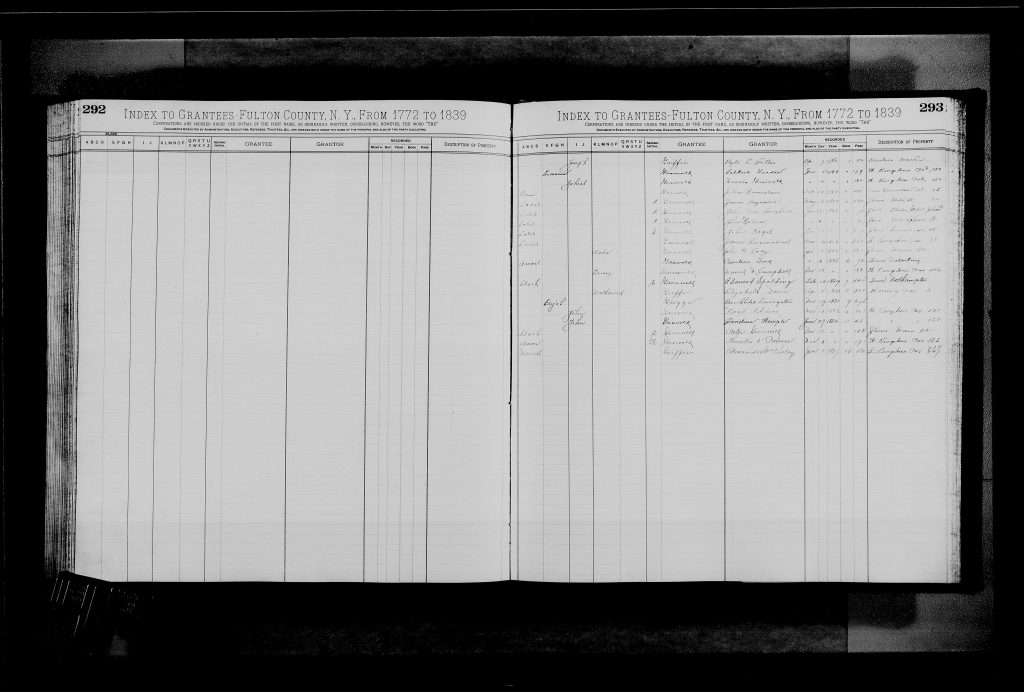
[13] William G. Griffis, Grantee of Property United States, New York Land Records, 1630-1975.”Index of Deeds, Line 2, Page 293, Database with images. FamilySearch. https://FamilySearch.org : 17 February 2023. Multiple county courthouses, New York. Date Ocober 28, 1841, https://www.familysearch.org/ark:/61903/1:1:6N73-61SR
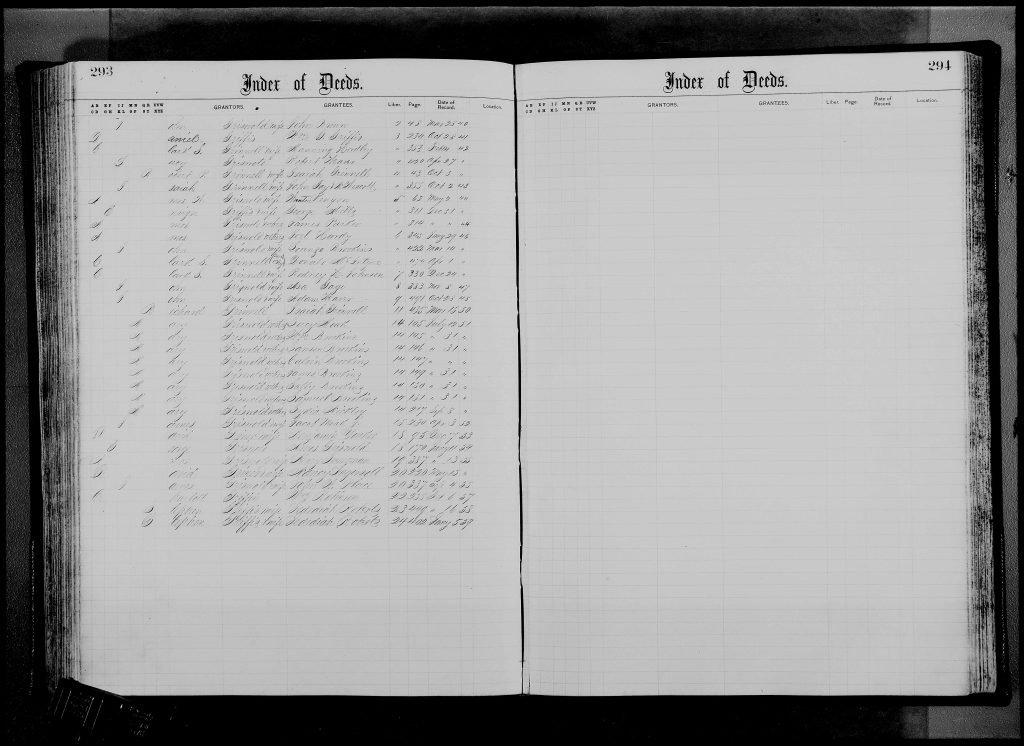
Joel Griffis purchased land from Moses Vail, Index of Deed, Book 435, Page 54, 1846
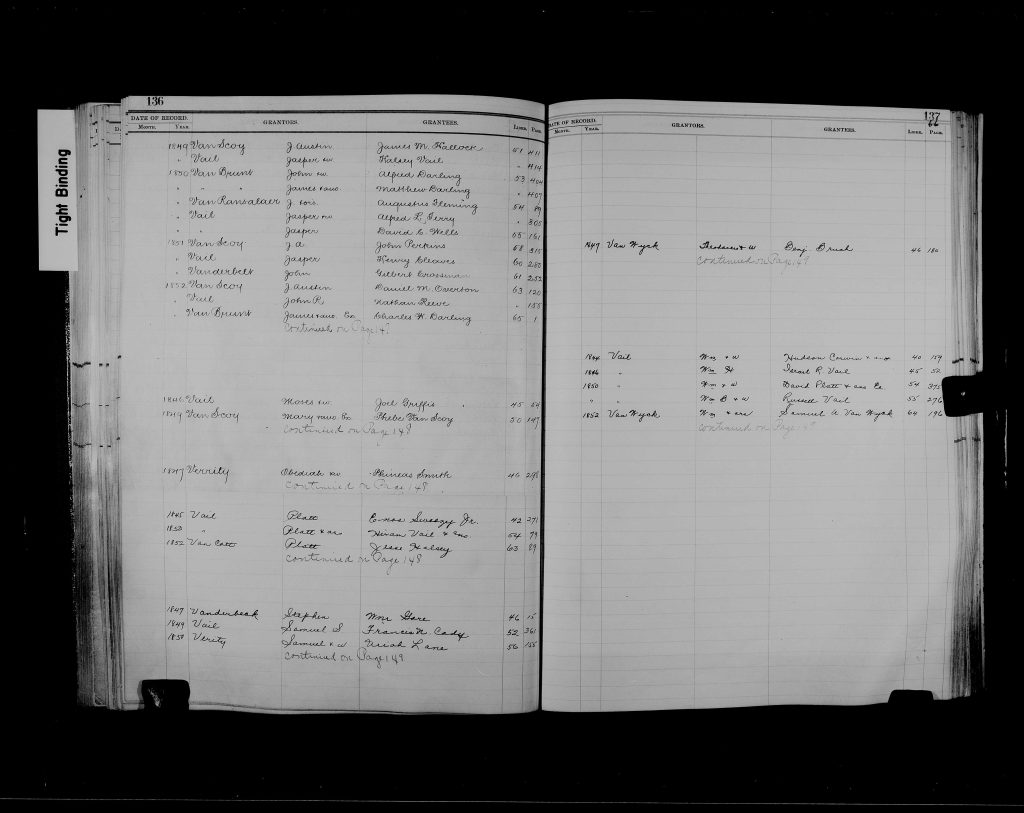
“United States, New York Land Records, 1630-1975”, Joel Griffis Grantee,Index of Deeds, Fulton County, Page 293 FamilySearch https://www.familysearch.org/ark:/61903/1:1:CCKY-JYMM , Joel Griffis in entry for Moses Vail, 1846.
[14] The first three state censuses for New York are difficult to access and largely unavailable online. Most records have been lost due to the 1911 State Capitol fire. All copies of this state census held by New York at that time were completely destroyed. In some cases, local NewYork county offices may have maintained copies of records from these first three censuses. I have not been able to determine if Fulton county has 1825, 1835 and 1845 census material available.
The second Constitution of the State of New York, written in 1821, required that a state census be taken in 1825 and every ten years after that—censuses were then taken ever ten years until 1875. No state census was taken in 1885. A state census was taken in 1892 and the 1895 census was skipped. The census was resumed every ten years in the fifth year of each decade (e.g. 1905, 1915, and 1925). The state census was officially abolished in 1931.
New York State Census Records Online, New York Genealogical and Biographical Society, https://www.newyorkfamilyhistory.org/subject-guide/new-york-state-census-records-online#25-35-45
Fire at the New York State Library, May 04, 2018, New York Genealogical and Biographical Society, https://www.newyorkfamilyhistory.org/blog/fire-new-york-state-library
[15] Daniel Griffis household, 1830 United Stated Federal census, New York, Albany County, Watervliet, page 470. Line14 image of 53 filmstrip. See copy of census page.
[16] 1840; Census Place: Mayfield, Fulton, New York; Roll: ; Page: 331, Line 11 1840 United States Federal Census, New York, Fulton County, Mayfield, page 332, Line 5, image 14 of 29 filmstrip. See copy of census page.
[17] New York State Census Records Online, New York Genealogical and Biographical Society, https://www.newyorkfamilyhistory.org/subject-guide/new-york-state-census-records-online#25-35-45
[18] 1855, New York State Census, Fulton, Mayfield, E.D. 1, Page 499 Line 27 – 31
[19] 1850 U. S. Federal Census, New York, Fulton County, Town of Mayfield, Page 38 , Lines 6 -10
1855, New York State Census, Fulton, Mayfield, E.D. 1, Page 499 Line 27 – 31
[20] The fact that Ester Griffis was living with his brother Daniel in 1850 is not a definitive fact. As reflected in table three, there is an “Esther” living in the house and is reported to be 86. I do not know who else in the Griffis family that remotely resembles this profile other than Esther, Daniel’s older sister.
Little is known about Esther Griffis. She is is listed as being baptized on February 27, 1774 in Huntington, New York. She is the second daughter and eighth child of William Griffis and Abiah Gates. She was born allegedly born in 1773. If born in 1773, then she would have been 77 in the 1850 Federal census which appears askance from a reported age of 86.
A family manuscript indicates that Esther died on June 28, 1829 in an unpublished family manuscript However there is no corroborating evidence to substantiate her death and her burial. See:
Giving Descendants of James Griffis (Griffith) b. 1758 in Huntington, Long Island, New York, compiled by Capitola Griffis Welch, 1972 . Page 8. PDF copy of the manuscript can be found here.
From Records of the First Church in Huntington, Long Island, 1723 – 1779, Being the Records Kept by the Rev. Ebenezer Prime the Pastor During Those Years, (from old catalog) (Huntington, NY: Moses L Scudder, 1899), page 58
[21] U. S. 1810; Census Place: Watervliet, Albany, New York; Roll: 26; Page: 132; Line 12, Image: 00015; Family History Library Film: 0181380
1820 U. S. Census; Census Place: Niskayuna, Schenectady, New York; Page: 132; Line 16,NARA Roll: M33_65; Image: 140
1830; U. S. Census Place: Watervliet, Albany, New York; Series: M19; Roll: 84; Page: 470; Line 14, Family History Library Film: 0017144
1840; U. S. Census Place: Mayfield, Fulton, New York; Roll: ; Page: 331, Line 11
[22] Initially, Niskayuna was part of Watervliet, which was a much larger entity in terms of geographical area. On March 7, 1809, Niskayuna was formed from Watervliet, Albany County, marking an administrative separation and the creation of Niskayuna as an independent entity. This division was part of a larger reorganization that led to the formation of Schenectady County from Albany County.
The early history of both areas is marked by the presence and activities of Dutch settlers and the interactions with local Native American tribes, specifically the Mohawk people, who were part of the Iroquois Confederacy. The area was known for its fertile lands, particularly for corn cultivation, which is reflected in the name “Niskayuna,” derived from the Mohawk language, signifying “extensive corn flats”
Niskayuna, New York, Wikipedia, This page was last edited on 7 March 2024, https://en.wikipedia.org/wiki/Niskayuna,_New_York
Rev. E. E. Taylor, Niskayuna Township History, Schenectady County, New York, http://genealogytrails.com/ny/schenectady/history_niskayuna.html
Watervliet (town), New York, Wikipedia, This page was last edited on 1 February 2024, Watervliet_(town),_New_York
History, Town of Niskayuna, Page accessed March 13, 2024, https://www.niskayuna.org/about_niskayuna/history.php
Austin Yates, Schenectady County New York, Its History to the Close of the Nineteenth Century, New York; New York History Company 1902
Niskayuna, New York, Wikipedia, Page updated 22 February 2022, Page accessed 27 Feb 2022
Horatio Gates Spafford, LL.D. A Gazetteer of the State of New-York, Embracing an Ample Survey and Description of Its Counties, Towns, Cities, Villages, Canals, Mountains, Lakes, Rivers, Creeks and Natural Topography. Arranged in One Series, Alphabetically: With an Appendix… (1824), at Schenectady Digital History Archives, selected extracts, accessed 27 Feb 2022
George Rogers Howell and John H. Munsell (1886). “History of the Township of Niskayuna”. History of the County of Schenectady, N.Y., from 1662 to 1886. New York City, NY: W.W. Munsell.
[23] Stephen Gates, 1790 United States Federal Census, New York, Albany, Watervliet, Line 23, Page 138. On line 21 there is a William Griffins. The household of Stephen Gates included 3 white males under 16 and one white male over 16 (Stephen Gates), and 6 white females.
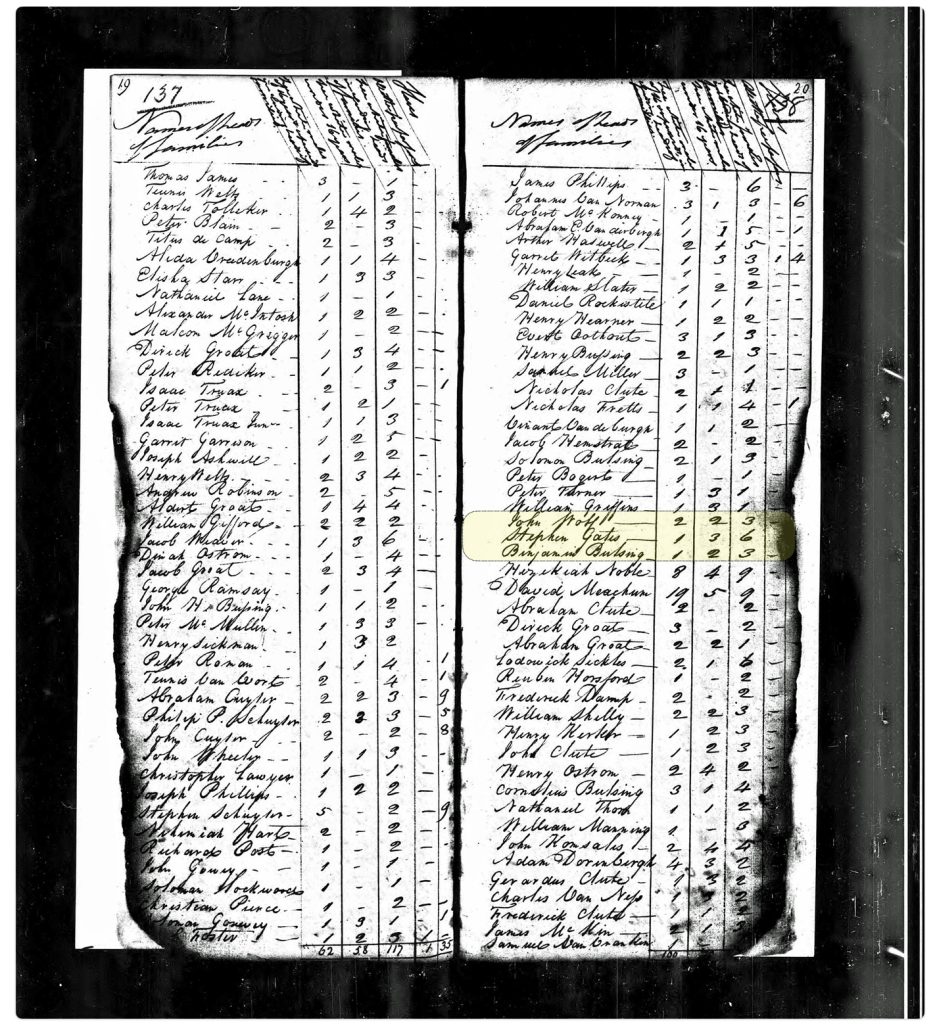
[24] Stephen Gates, 1790 United States Federal Census, New York, Albany, Watervliet, Line 23, Page 138.
1800; Census Place: Watervliet, Albany, New York; Series: M32; Roll: 22; Page: 52; Image: 57; Family History Library Film: 193710
1810; Census Place: Watervliet, Albany, New York; Roll: 26; Page: 16; Image: 00017; Family History Library Film: 0181380
1820 U S Census; Census Place: Niskayuna, Schenectady, New York; Page: 132; NARA Roll: M33_65; Image: 140
1830; Census Place: Schenectady, Schenectady, New York; Series: M19; Roll: 116; Page: 225; Family History Library Film: 0017176
[25] Nathaniel Griffes Gates, Find a Grave, memorial 8743987, Birth 16 Nov 1819, Schenectady, Schenectady County, New York, Death 16 Aug 1898 (age 78), Buried in Forest Hill Cemetery, Ann Arbor, Washtenaw County, Michigan, Plot: Block 21 Lot 1.
[26] The surname of Nathaniel Griffis is spelled as Griffis, Griffith and Griffes in various sources. His name is spelled as Nathan Griffis in the list of enlisted soldiers. Albany County Militia (Land Bounty Rights) — Sixth Regiment, New York Military in the Revolution.
There are a number of sources which document the spelling of the Griffis(ith)(es) name for Daniel’s brother Nathaniel Griffes and his descendents. For example see: Nathaniel Griffes, Find a Grave, Memorial ID 128512209, Vale Cemetery, Schenectady, Schenectady County, https://www.findagrave.com/memorial/128512209/nathaniel-griffes
Vale Cemetery, 16 family members with name Griffes buried in Cemetery, https://www.findagrave.com/cemetery/66580/memorial-search?firstname=&middlename=&lastname=Griffes&cemeteryName=Vale+Cemetery&birthyear=&birthyearfilter=&deathyear=&deathyearfilter=&memorialid=&mcid=&linkedToName=&datefilter=&orderby=r&plot=
His cousin named a son in honor of Nathan: Nathaniel Griffes Gates, Find a Grave, memorial 8743987, Birth 16 Nov 1819, Schenectady, Schenectady County, New York, Death 16 Aug1898 (age 78), Buried in Forest Hill Cemetery, Ann Arbor, Washtenaw County, Michigan, Plot: Block 21 Lot 1.
[27] Daniel Griffis household, 1810 United Stated Federal census, New York, Albany County, Watervliet, Line 6 image of 8 filmstrip.
Stephen Gates Jr. Household, 1810 United Stated Federal census, New York Albany County, Watervliet, page 1313. Line 3 image 1 of 8 filmstrip. See copy of census page.
Nathaniel Griffes household, 1810 United Stated Federal census, New York Albany County, Watervliet, page 1312. Line 20 image 1 of 8 filmstrip. See copy of census page.
Stephen Gates Household, 1810 United Stated Federal census, New York Albany County, Watervliet, page 1326. Line 4 image 8 of 8 filmstrip. See copy of census page.
[28] William G. Griffis, Find a Grave, Memorial ID
28262391, Riceville Cemetery, Mayfield, Fulton County, New York, https://www.findagrave.com/memorial/28262391/grif
1860 U.S. Federal Census, New York, Fulton County, Mayfield, Page 34, Line 29
[29] Daniel Griffis household, 1810 United Stated Federal census, New York, Albany County, Watervliet, Line 6 image of 8 filmstrip.
[30] Over the decades, the U.S. Federal Census evolved from relatively broad age categories to much more detailed ones, especially by the 1830 census.
1810 Census:
- Free White Males and Females:
- Under 10 years
- 10 and under 16 years
- 16 and under 26 years
- 26 and under 45 years
- 45 years and upwards
- Slaves and Other Free Persons were counted, but no age categories were specified for these groups in the provided sourcees.
1820 Census
- Free White Males and Females:
- Under 10 years
- 10 to 15 years
- 16 to 18 years (males only, also counted in the 16 to 26 category)
- 16 to 26 years
- 26 to 44 years
- 45 years and upwards
- Slaves and Free Colored Persons (Male and Female):
- Under 14 years
- 14 to 25 years
- 26 to 44 years
- 45 years and upwards
1830 Census
- Free White Males and Females:
- Under 5 years
- 5 to 10 years
- 10 to 15 years
- 15 to 20 years
- 20 to 30 years
- 30 to 40 years
- 40 to 50 years
- 50 to 60 years
- 60 to 70 years
- 70 to 80 years
- 80 to 90 years
- 90 to 100 years
- 100 years and upwards
- Slaves and Free Colored Persons (Male and Female):
- Under 10 years
- 10 to 24 years
- 24 to 36 years
- 36 to 55 years
- 55 to 100 years
- 100 years and upwards
- Additional categories for deaf, dumb, and blind individuals were introduced
1840 Census
The age categories in the 1840 federal census were as follows:
- Free White Males and Females:
- Under 5 years
- 5 to 10 years
- 10 to 15 years
- 15 to 20 years
- 20 to 30 years
- 30 to 40 years
- 40 to 50 years
- 50 to 60 years
- 60 to 70 years
- 70 to 80 years
- 80 to 90 years
- 90 to 100 years
- 100 years and upward
- Slaves and Free Colored Persons (Male and Female):
- Under 10 years
- 10 to 24 years
- 24 to 36 years
- 36 to 55 years
- 55 to 100 years
- 100 years and upward
Additionally, the 1840 census included categories for deaf and dumb persons, blind persons, and insane and idiots, with specific age categories for deaf and dumb individuals
1810, Index of Questions, United States Census Bureau, https://www.census.gov/history/www/through_the_decades/index_of_questions/1810_1.html
1820, Index of Questions, United States Census Bureau, https://www.census.gov/history/www/through_the_decades/index_of_questions/1820_1.html
1830, Index of Questions, United States Census Bureau, https://www.census.gov/history/www/through_the_decades/index_of_questions/1830_1.html
1840, Index of Questions, United States Census Bureau, https://www.census.gov/history/www/through_the_decades/index_of_questions/1840_1.html
[31] Daniel Griffis household, 1810 United Stated Federal census, New York, Albany County, Watervliet, Line 6 image of 8 filmstrip.
[32] Depending on life sources for Natan, his name is spelled as Griffis, Griffith or Griffes.
[33] 1820 U S Census; Census Place: Niskayuna, Schenectady, New York; Page: 132; NARA Roll: M33_65; Images 139 and 140
[34] The cousin of Nathanial Griffes named a son in honor of Nathan: Nathaniel Griffes Gates, Find a Grave, memorial 8743987, Birth 16 Nov 1819, Schenectady, Schenectady County, New York, Death 16 Aug1898 (age 78), Buried in Forest Hill Cemetery, Ann Arbor, Washtenaw County, Michigan, Plot: Block 21 Lot 1.
Will of Nathaniel Griffes, U.S. Wills and Probate Records, 1659 – 1999, Schenectady Wills, Vol D – E, 1832 – 1845, date of Will 20 May 142, date of Probate 15 Apr 1842, Probate Place Schenectady NY, Image 325 – 327, Pages 386 – 390. See PDF copy of will.
[35] Death of a Stephen Griffis, The Christian Intelligencer of the Reformed Dutch Church U.S., Newspaper Extractions from the Northeast, 1704-1930 Vol IV, No 198 May 17, 1834.

Ancestry.com. U.S., Newspaper Extractions from the Northeast, 1704-1930 [database on-line]. Provo, UT, USA: Ancestry.com Operations, Inc., 2014. This collection was indexed by Ancestry World Archives Projectcontributors.
Original data: Newspapers and Periodicals. American Antiquarian Society, Worcester, Massachusetts.
This collection contains marriage and death details extracted from various newspapers from Massachusetts, Connecticut, and New York. Details may include names, event dates, ages, family relationships, and other facts of interest.
[36] 1850 U.S. Federal Census, New York, Sacatoga County, Charlton, Page 28 , Line 24 – 32
Ruth Cromer, 1811 – 1871, Prospect Hill Cemetery, Memorial ID 120140838, Sec 2 Cromer LotFind a Grave, https://www.findagrave.com/memorial/120140838/ruth-cromer
[37] Daniel Griffis, grantee, Alexander McKinely & Wife, New York, Fulton County Deeds, June 1, 1837, Volume 13 Pages 50-51, Image 229 https://www.familysearch.org/ark:/61903/3:1:3QS7-99WC-XTY5?i=298&wc=M7H5-8TL%3A358134701%2C358292701&cc=2078654
Scanned Copy of the Original Deed to Property Page 50

Scanned Copy of the Original Deed to Property Page 51
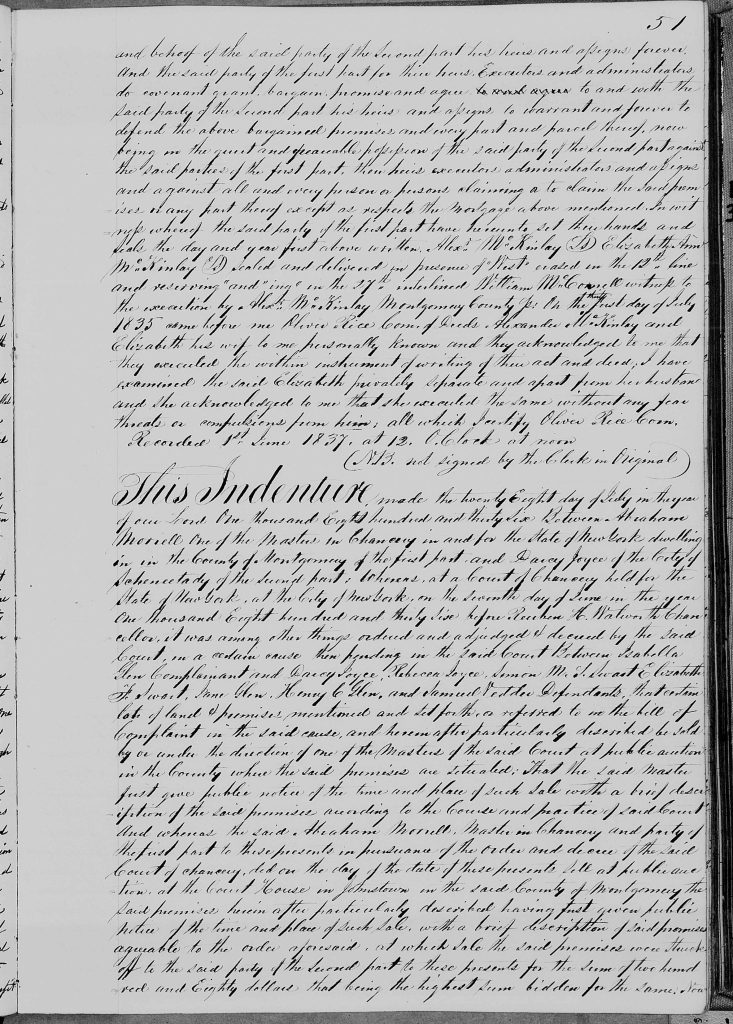
Transcription of the deed:
Page 50: (Portions of document in BOLD is mine.)
This indenture made the thirty first day of July in the year of our lord One thousand Eight hundred and thirty five Between Alexander McKinlay of Mayfield in the County of Montgomery and there State of New York and Elizabeth his wife of the first part and Daniel Griffis of the same town of the second part witnesseth that the said parties of the first part for and in consideration of the sum of Six hundred and nineteen dollars money of account of the United States to them in hand paid by the said party of the second part the receipt whereof is hereby confessed and acknowledged. Have granted bargained, Sold, remised released aliened and confirmed and be theses present to do bargain, sell, remise, release, alien and confirm unto the said party of the second part, and to his heirs and assigns forever All that certain piece or parcel of land situate lying and being Mayfield aforesaid aforesaid (sic) and know as being parts of lots number two hundred and thirty Eight and two hundred and forty seven in the eastern allotments of Kingsborough Patent and is bound as follows, [?]: Beginning at the South East corner of said Lot number two hundred and Thirty eight and running thence on the South line of said lot South Eighty Eight degrees and thirty minutes west to the East bank degrees and thirty minutes west to the East bank of the Creek, at high water mark thence down the said East bank of the creek at the highwater mark as it winds and turns to a line drawn parallel with the said South line of said lot through the middle of said lot; thence on said line North Eighty Eight degrees & thirty minutes East to the East line of said lot; thence along the same being the west bounds of said lot number two hundred and forty seven North one degree and thirty minutes west to the highway leading from Anthony to Chases; thence North Easterly along said highway to the north line of said lot number two hundred & forty seven thence, along said north line, north Eighty Eight degrees and thirty minutes east to a Stake and Stones Eleven chains and fifty links from the North west corner of said lot last mentioned; thence South one degree and thirty minutes twenty four chains and fifty links; thence North Sixty degrees East seventy one links; thence South forty one degree & thirty minutes East four chains & thirty five links; thence South fifty three degrees and twenty minutes west seventeen chains and Eighty Seven links to the west line of said lot last mentioned; thence along the same south one degree and thirty minutes East to the place of Beginning supposed to contain one hundred and ten Acres more or less excepting therefrom and hereby always reserving the mile lot thereon containing one acres or less, with the saw mill on the Creek aforesaid with priviledges and appearances thereunto belonging and the privilege of a lane from the highway to said saw mill an mill lot the whole Subject to a mortgage executed by the said McKinely to Jacob Woodworth in may last to secure the payment of five hundred Eighty One dollars which the Said Griffis agrees to discharge Together with all and Singular the hereditaments and appurtenances thereunto belonging or in any wise appertaining and the reversion and reversions remainder and remaindus, rents, issues, and profits, thereof and all the estate right title interest claims and demand party of the first part either in law or Equity in and to the above bargained premises with the hereditaments and appurtenances to have and to hold the lands tenements, hereditaments rights and privileges above mentioned granted and described and every part and parcel thereof to the said party of the second part his heirs and assigns to the sole and only proper use benefit
Page 51
and behoof of the said party of the second part his heirs and assigned forever and the said party of the first part for their heirs. Executors and administrators do covenant grant bargain promise agree to and with the said party of the second part his heirs and assigns to warrants and forever to defend the above bargained promises and agree to and with the said party of the second part his heirs and assigns to warrant and forever to defend the above bargained premises and every part and parcel thereof, now being in the quiet and peaceable possession of the said party of the of the second part against the said parties of the first part, their heirs executors administrators and assigns and against all and every person or persons claiming or to claim the said premises or any part thereof except as respects the mortgage above mentioned . In witnessed whereof the said party of the first part have hereunto set their hands and Seals the day and year above written Alex McKinlay Elizabeth Ann McKinlay Sealed and delivered in presence of “West” erased in the 12th line and reserving “and”ing” in the 27th interlined William McConnell witnessed to the execution by Alex McKinlay Montgmery County ss: On the first day of July 1 1835 came before me Oliver Rice Com. Of Deeds Alexander McKinley and Elizabeth his wife to me personally known and they acknowledged to me that the executed the within and instrument of writing of their act and the deed, I have examined thesis Elizabeth privately separate and apart from her husband and the acknowledged to me that she excepted the same without any fear threats or compulsions from him, all which I certify Oliver Rice Com. Recorded 1st June 1837 at 12 O,Clock at noon. (N.B. not signed by the Clerk in Original)
[38] 1828 Map of the County of Montgomery. By David H. Burr. Published by the Surveyor General, pursuant to an Act of the Legislature. Entered according to an Act of Congress Jany. 5th. 1829 by David H. Burr of the State of New York. Engd. by Rawdon, Clark & Co., Alby. & Rawdon, Wright & Co., N. York. Page 17. David Rumsey Map Collection, https://www.davidrumsey.com/luna/servlet/detail/RUMSEY~8~1~20020~510016:Montgomery-County-?qvq=q:Montgomery%20County;lc:RUMSEY~8~1&mi=11&trs=221
This atlas is the second atlas published in the 19th century of one of the individual states in the U.S., preceded only by Mill’s Atlas of South Carolina, issued in 1825, and followed closely, also in 1829, by Greenleaf’s Atlas of the State of Maine
Click here for a full version of the map. Clich here for a zoomable version that provides more detail .
[39] William Loveday, Jr, Fulton County Historian, Birth of a County, 13 May-2008, https://fulton.nygenweb.net/history/WLbirth.html
Reid, W. Max, The Story of Old Fort Johnson, Chapter XV Land Grants: Royal, Kingsborough, Sacandaga – Johnson Hall, New York: G. P. Putnam’s Sons, 1906
Tables of Manors, Colonial Patents, Purchases, and Land Grants, Genealogy Trails History Group, https://genealogytrails.com/ny/landpatents.html
Campbell, Colin D., and Rosemary G. Campbell. “Early Land Leases in the Cherry Valley Patent, 1743–1851.” New York History, vol. 90, no. 1/2, 2009, pp. 59–77. JSTOR, http://www.jstor.org/stable/23185097
[40] Betty Tabor, Mayfield Historian, History of Mayfield, Mayfield’s Community Page, 1999, Last updated 13 May 2008, https://fulton.nygenweb.net/towns/fulnmayfeild.html
[41] Mayfield, New York, Wikipedia, This page was last edited on 7 January 2024, https://en.wikipedia.org/wiki/Mayfield,_New_York
[42] “The Maps of the Commissioners of Forfeitures” in the New York State Archives in Albany, New York Collection #AO273, Portfolio E – Map #859
[43] William Loveday, Jr, Fulton County Historian, Birth of a County, 13 May-2008, https://fulton.nygenweb.net/history/WLbirth.html
Reid, W. Max, The Story of Old Fort Johnson, Chapter XV Land Grants: Royal, Kingsborough, Sacandaga – Johnson Hall, New York: G. P. Putnam’s Sons, 1906
[44] E-mail correspondence between me and Eric Close March 22, 2024. As Historian of Maryfield, New York, Eric has not only provided the handwritten notes of the Reverend Ruliffson but created ,on a moment’s notice, the contemporary map to illustrate the location of sections of he Kingsborough patent.
[45] 1930 state highway renumbering (New York), Wikipedia, This page was last edited on 3 February 2022, https://en.wikipedia.org/wiki/1930_state_highway_renumbering_(New_York)
Leon A. Dickinson, NEW SIGNS FOR STATE HIGHWAYS; A Better System of Route Numbers Is Now to Be Introduced, and Some of the Roads Are to Have Different Designations, Jan. 12, 1930, New York Times, https://www.nytimes.com/1930/01/12/archives/new-signs-for-state-highways-a-better-system-of-route-numbers-is.html
[46] New York State Route 30, Wikipedia, This page was last edited on 20 February 2024, https://en.wikipedia.org/wiki/New_York_State_Route_30
New York State Route 30, Wikiwand, https://www.wikiwand.com/en/New_York_State_Route_30#google_vignette
New York State Route 30A, This page was last edited on 8 January 2023, https://en.wikipedia.org/wiki/New_York_State_Route_30A
List of county routes in Fulton County, New York, Wikipedia, This page was last edited on 9 February 2024, https://en.wikipedia.org/wiki/List_of_county_routes_in_Fulton_County,_New_York ;
[47] ‘Chains and links’ are the traditional units for measuring distances in surveying, dating back to the 1600s. Degrees, minutes and seconds are the angular units used to measure directions and angles between surveyed lines. Understanding these basic units is essential for reading older survey plans and deeds.
In surveying, chains, links and degrees are units of measurement used for distances and angles. Here are the key definitions:Chains and Links:
- A chain is a unit of length equal to 66 feet (22 yards), used in both the US customary and Imperial unit systems. It is subdivided into 100 links. See Chain (unit), Wikipedia, This page was last edited on 12 February 2024, https://en.wikipedia.org/wiki/Chain_%28unit%29
- A link is a unit of linear measure, one hundredth of a chain and equivalent to 7.92 inches (20.12 cm).25 Link (unit), Wikipedia, This page was last edited on 24 November 2023, https://en.wikipedia.org/wiki/Link_%28unit%29
- 80 chains make up 1 mile (5280 feet). Other conversions:
- 1 chain = 100 links or 66 feet
- 1 rod/pole/perch = 25 links or 16.5 feet
- 1 furlong = 10 chains
- 1 acre = 10 square chains
Understanding Survey Measurement Terms, January 18, 2010, Point to Point Land Surveyors, https://www.pointtopointsurvey.com/2010/01/understanding-survey-measurement-terms/
Degrees:
- Angles in surveying are measured in degrees, with each degree subdivided into 60 minutes, and each minute subdivided into 60 seconds. See Understanding Surveys, Chastain & Associates, PC, Surveying Planning Consulting, https://chastainassociates.com/understanding-survey-concepts/
- A full circle contains 360 degrees. A right angle is 90 degrees.
- Bearings are stated as an angle from due north or south, specifying the quadrant (NE, SE, SW, NW).
- Azimuths are angles measured clockwise from north or south through 360 degrees.
Angle Definitions for Land Surveyors, LearnCST, https://learncst.com/angle-definitions/
Degrees are a fundamental unit for measuring angles in surveying. Daniel’s Deed refers to “Eighty Eight degrees and thirty minutes east’ in addition to a number of other angles. Here are the key ways degrees are used:
- Measuring horizontal angles: Surveyors use degrees to measure horizontal angles between lines. For example, the angle between two property boundaries or the angle a survey line makes with north. A full circle is 360°.
- Measuring vertical angles: Degrees are used to measure vertical angles, such as the angle of elevation or depression to a point. Vertical angles range from 0° (horizontal) to 90° (straight up or down).
- Bearings: Bearings indicate a direction and are stated as an angle (in degrees) east or west from a north-south reference line. Bearings are always less than 90°.369 For example, N 60° 30′ E.
- Azimuths: Azimuths also indicate direction but as an angle measured clockwise from north or south, ranging from 0° to 360°.3615 For example, an azimuth of 120° is 120° clockwise from north.
- Latitude and departure: When calculating coordinates from field measurements, the horizontal angles (in degrees) are used to compute the latitude (northing) and departure (easting) of survey lines.
- Accuracy standards: Professional surveying organizations specify minimum angle measurement accuracy in degrees or fractions thereof, such as 15 seconds (1/240th of a degree).
What Degree Does a Land Surveyor Need? (Plus Job Duties), Jan 26, 2023, Indeed, https://www.indeed.com/career-advice/finding-a-job/what-degree-does-land-surveyor-need
Shree Swami, Angular measurement for surveying, Dec 17, 2016, Slideshare, https://www.slideshare.net/balarkarm03/angular-measurement-for-surveying
Neenu, S.K., Azimuths and Bearings in Surveying-Difference & Determination, The Constructor, https://theconstructor.org/surveying/azimuths-bearings-surveying-difference-determination/38494/?amp=1
[48] Chace, J, and Robert Pearsall Smith. Map of Fulton County, New York: from actual surveys. Philadelphia: Published by Jno. T. Hill, 1856. Map. Library of Congress, https://www.loc.gov/item/2012593659/
[49] 1850 U.S. Census Non-Population Schedules, New York, Fulton County, Broadalbin, Page 223 – 224, Line 19


